First stop was the abandoned lighthouse at Vlamingh Head. From our vantage point we could see the Ultra Low Frequency transmitter tower, a complex of 13 towers held in place by a tangle of support wires with the antenna suspended from the tops of the towers [2020 Note: When studying geophysics I learnt how the emissions from this transmission station can be used to investigate geological structures]. The lighthouse is at the top of a 50-metre-high cliff, but the towers are as high again. Consequently, the light from the lighthouse has been transferred to the top of one of the towers.
A rusty iron structure and a heap of tangled wire is all that remains of an aircraft warning radar of World War Two vintage, which was destroyed by a cyclone after the war.
The blue water of Exmouth gulf and the Indian Ocean stretched away into the distance, on both sides of NW Cape. It was very calm in the Gulf to the East, but a big sea was dashing itself on the fringing Ningaloo reef to the west and southwest.
From here we went to the Cape Range National Park visitors centre and were waiting on the door straight step at 10:00 AM when it opened. The buildings were the usual national parks type of structures, but in this case very energy efficient and environmentally friendly. Electrical power comes from solar cells which store energy in batteries from where it is drawn and converted to 50Hertz and 240 volts AC (as a modified square wave rather than a sine wave). This is then used to drive energy efficient fans and low power lights.
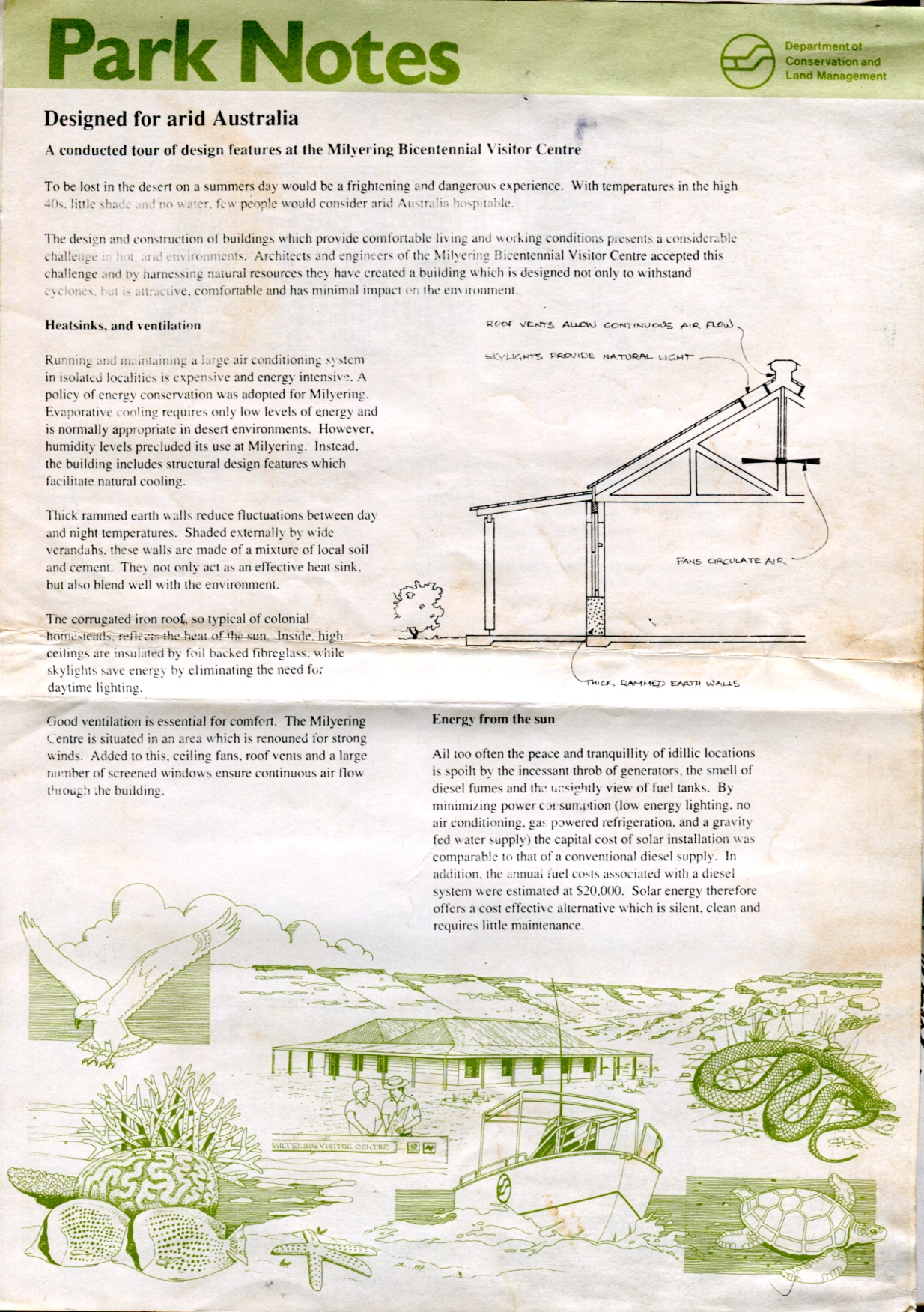
The toilets are especially designed pit toilets which digest the waste with great efficiency, or so we are told. Jacqui notes in the diary that they're called Clivus Multrum toilets.
The Cape range National Park incorporates the western half of the Northwest Cape, which is basically a series of coral reef relics and the associated intertidal platforms produced as the sea level fell during the last 4000 years.

We stopped at one of the many camping spots, a place called Ned's camp [2020 note: I can’t find this on any maps]. Here the kids swam in the clear warm water- I think you might have heard that phrase before - in the lagoon behind Ningaloo Reef. The adults sat on the white coral sand watching the kids with our faces caressed by a warm north-easterly breeze.
We returned to Stuart and Melinda's home for lunch after which Stuart took me for a ride on his belt driven, 1340cc Harley-Davidson. It was noisy with strong engine vibrations, but it had impressive levels of grunt! The lack of a fairing and upright riding position could make long distance riding a challenge.
For dinner we had a lazy barbie and Stuart and I were up long after everyone else was in bed sampling his extensive range of ports.
Thursday 19th April 1990
When I awoke at around 6:30 AM I was surprised to hear that drip, drip, drip of water from the roof. During the warm humid night, dew had formed on the roof of Stuart and Melinda’s house, and was now dripping directly onto the ground as the house has no gutters - Melinda explained that as it hardly ever rains, and when it does it is usually during a cyclone, no gutter could cope with the volume of water anyway.
After packing up, and saying our farewells(we were very grateful for Stuart and Melinda's hospitality and we enjoyed our stay with them immensley), we travelled 83 kilometres south to Burkett road – a shortcut which saved us travelling the 255 kilometres to Minilya Roadhouse and then 120 kilometres North again. We were a little concerned about this road as people, including council workers, had warned us it was very rough. Indeed, in places it was, but generally the surface was acceptable, and the 86 kilometres took us an hour and a half. A valuable saving in time and money.
On our trip to Tom Price we were impressed by huge red sand dunes. The most interesting part though, was near Tom Price where we saw majestic mountain ranges made of banded iron formations. The colours were impressive as the sun approached the horizon, highlighting the reds of the iron ore rich beds. As usual we witnessed the result of futile confrontations between cattle, kangaroos and reptiles and the cars and trucks which use this road.
Alison Anderson [2020 note: Alison was a student of Ian's at Barrenjoey high school in the early 1980s. After leaving school she trained as a geologist] made us feel welcome at her well-appointed Tom Price townhouse. We spent most of the night, after the kids were in bed, looking through her photo albums which showed various aspects of her professional life as a geologist with CRAE (Conzinc Rio Tinto Australia Exploration) and her recreation time in the area. The day had been hot, but the night was cool and mild which made sleeping easy.
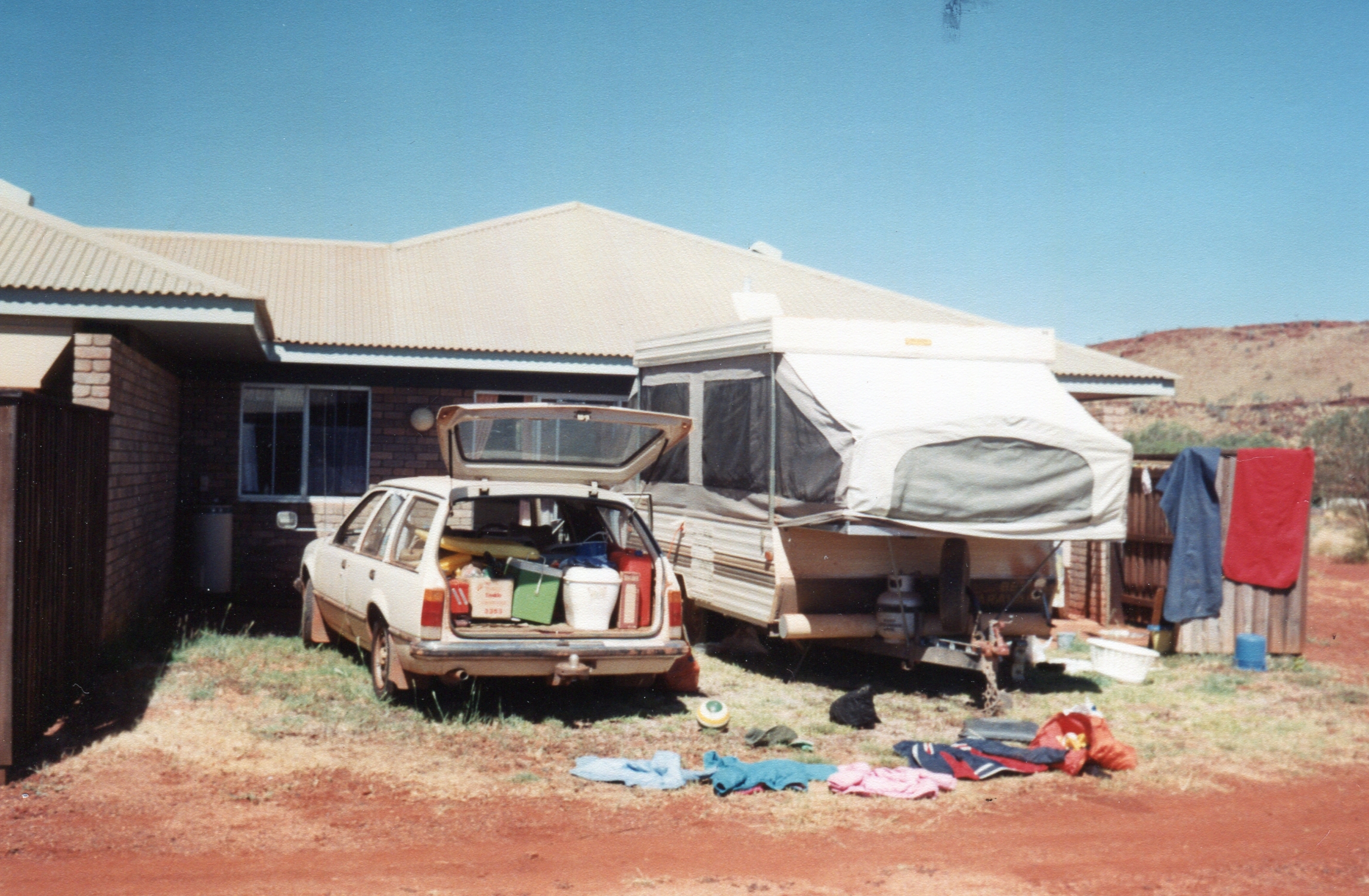
A photo, taken by one of the kids on their Olympus Trip camera, of our Jayco Lark Camper trailer and 1981 Holden Commodore in the back yard of Alison Anderson's Tom Price home. We were doing a clean out - hence all the stuff on the ground.
Friday 20th April 1990
As soon as the sun hit the side of the caravan It began to warm up. The night had been cool and very pleasant
Allison was at work, so we went into town and organised a fax message to the credit union for Jacqui’s tax and did the necessary shopping. On the way home an ore train passed us, and we sat for as long a time as we could watching it pass before it got too hot in the car. [2020 note: our car’s air conditioner did not work].
At 1:00 PM everyone was scrambling around in a box full of yellow hard hats as we prepared to board the Hamersley Iron coach for a tour of the mine. The kids looked great in the hard hats, which were miles too big!
The tour, which took about 1 1/4 hours, showed us various aspects of the mine and its operation. Amongst other things the equipment was huge. Haul trucks called Lectra Hauls and Terixo dwarfed normal vehicles and everything was on a huge scale. Jacqui notes that Allison saw a film where a Lectra haul reversed over a four-wheel drive car that had parked too close to the truck.
Twice a day these trucks are refuelled taking 2100 litres of diesel, the tyres cost $13,000 each and are 58 plies, while the huge diesel engines are part of a diesel electric system similar to that used in diesel electric locomotives.
Looking down from our vantage point at the edge of the pit we saw terraces of 15 metres each step-down hundreds of metres to the bottom. We were shown a large boulder drilled through with the drills used to place the blasting slurry, a mixture of ammonium nitrate and 6% diesel fuel, ignited by fuses which burn at 7 kilometres per second. Electric fuses are unsafe due to the possibility of accidental detonation by radio transmissions. The shot holes are 30 centimetres in diameter and 18 metres deep. The drilling rigs take only one hour to drill each hole.
The BIF itself showed the most amazing structure
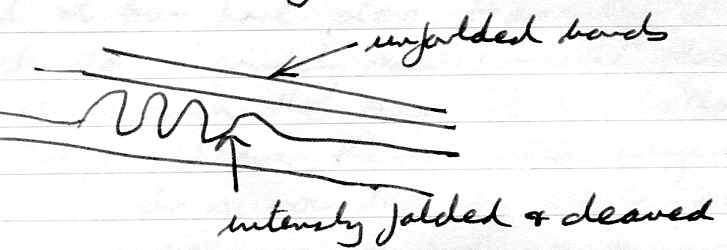
Allison told me this internal structure of BIF is not well understood, as no discontinuity exists between the folded bands and those undisturbed above and below. Further, the folding is also limited in lateral as well as vertical directions.
Not surprisingly everything is covered in red dust, the vehicles, the machines, crushing and concentrating plants, as well as the people. There was one exception though, a huge shovel which had commenced work only that day. It had been purchased from Bougainville Copper and reassembled here.
After the tour we filled the car with petrol, gained a permit to use the railway access road to the coast, and spent a very pleasant hour or so in the local pool.
Dinner that evening was a baked dinner, leg of lamb accompanied by a bottle of Oberge (our home-made wine) which is getting better all the time. [2020 note: Looking back, our wine was terrible, so this comment can only mean that it was getting "less terrible" with bottle age]
The kids went to sleep early, giving us a good chance to talk in peace.
Saturday, 21 April 1990
After Alison had ridden into town on her bicycle to get supplies, we prepared and packed a lunch of cold chicken and meats, together with salad and drink. Then we headed along the railway access road for the Hammersley Range National Park.
As we travelled Alison explained the stratigraphy of the banded iron formation, BIF, which formed the mountains of the Pilbara, until we arrived at our first stop, Hammersley Gorge.
Here we walked down crudely made concrete steps and over shale and BIF to reach the oasis at the bottom. Cool green water flowed over the contorted layers of BIF and into pebbly ponds, surrounded by white trunked eucalypts.
The kids were soon paddling and swimming with the numerous small fish in the pools. On each side of the gorge rose cliffs of beautifully folded red and grey rocks, their structure highlighted by shadows which filled the gorge. After a suitable time, spent swimming and skimming rocks across the deeper water which passes through the narrowest section of the gorge and talking to a Swiss tourist who only leaves Australia to have his visa renewed, we left for Wittenoom.
The road followed a natural boundary, Forteque Valley to the north, a wide shallow apparently fertile valley and the Hammersley range rising abruptly to the south.
After a few kilometres of comfortable tar, we turned south along the Yampire Gorge Road, which winds along the gorge of the same name. In many ways it was like the Brachina gorge in the Flinders ranges, except for the old abandoned asbestos mine and trams used as miners’ accommodation.
Emerging from the gorge, the country flattened out to spinifex and hardy scrub. By the road we saw a camping area where “generators were allowed”. The national parks people must have similar feelings towards these noisy intrusions to camping, because the site was bare, dry and un-interesting – clearly, they didn’t want to pander to the “generator” set.
About five minutes later we stopped in the rocky car park above the (Yampire) gorge, a narrow green tree oasis snaking away about 50 m below us. The ants must have smelt our food, because we spent most of the time eating lunch, walking restlessly around trying to stay free of these ferocious black predators.
The 150 m walk down to the river was steep in places, but we were rewarded by a refreshingly cool swim in the pool at the foot of Fortescue falls. Before long, about 20 fellow tourists had joined us and it was just like the local pool - smells of food, drink, suntan lotion and cigarette smoke included.
At about 3 PM we decide to leave and visit a lookout about 30 km away to view the remaining gorges before heading home. Our plans didn’t see the light of sunset as, just as we crested a rise above a beautiful plain, surrounded by hills, the erratic handling of the car pulled us up short. The driver's side rear tyre was flat and worse was yet to come, as Alison found the passenger side rear tyre was producing a loud hissing sound.
Embarrassingly, Alison asked me where my extra spare wheel was and when I said we didn’t have one, she asked “okay where is your bead breaker and puncture repair kit?” Oops!
The hissing tire was not yet flat and we thought of trying to make a run for the nearest ranger station. We soon gave the idea away and tried for help the CB radio calling on channels eight and nine. No answer!
Then, the first car we had seen turned out to be an aboriginal ranger called Maitland who stopped and listened to our problems. Eventually he radioed the main station where he discovered they had to spare tubes, so he, Alison, Jacqui, and Lachlan, with two flat tyres went back to fix same.
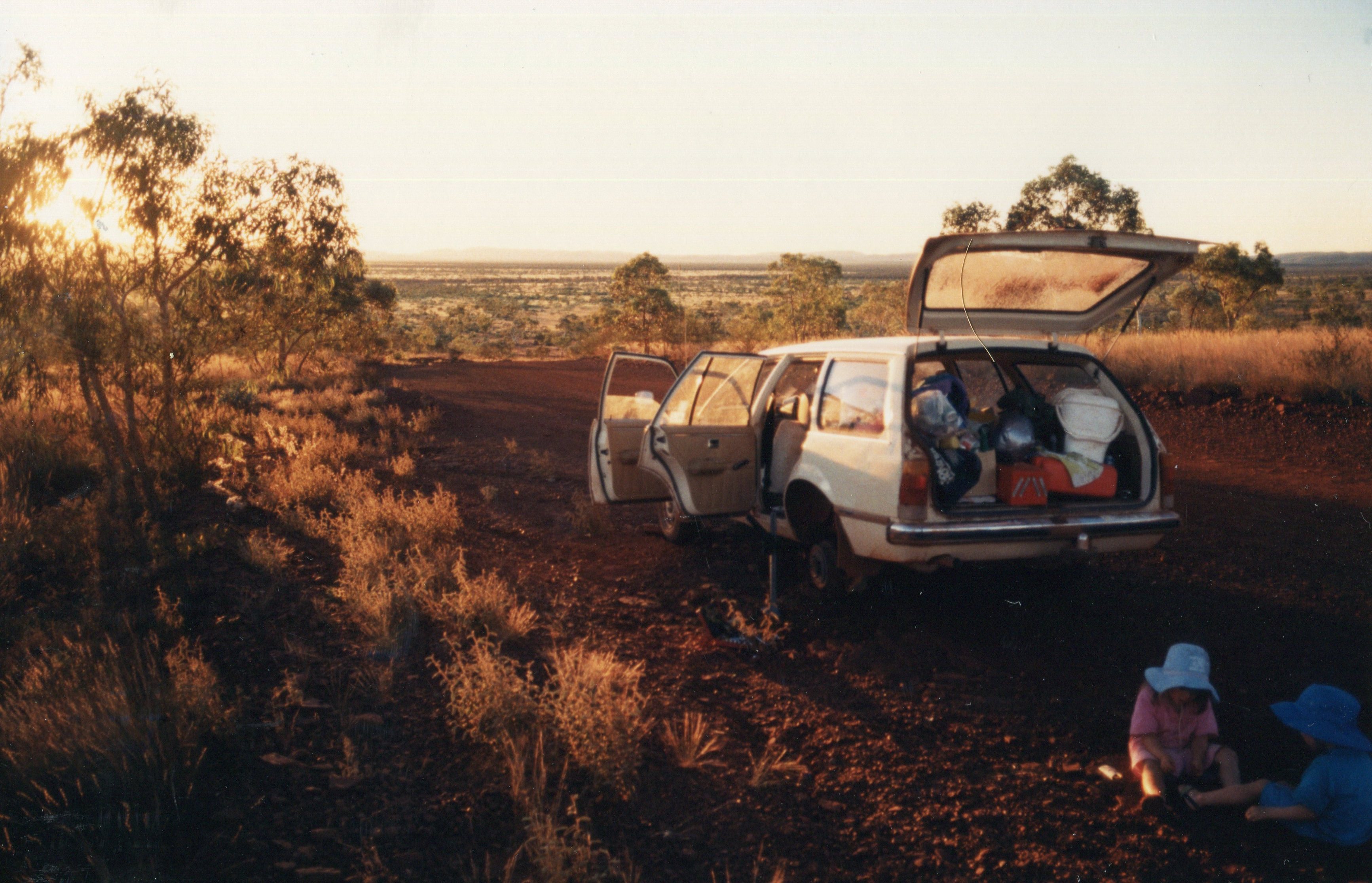
Our commodore without its 2 rear wheels. Jacqui Lachlan and Alison Anderson had gone with a ranger to attempt to fix the punctures, while I stayed at the car with Rohan and Anja
Anja, Rohan and I spent the next hour, as the sun set, looking at lizards, the local birds, singing and talking to the six or so cars which came past and stopped to offer help. In fact, the first car past gave me two cans of EMU export beer, a welcome gift in the 30°C heat.
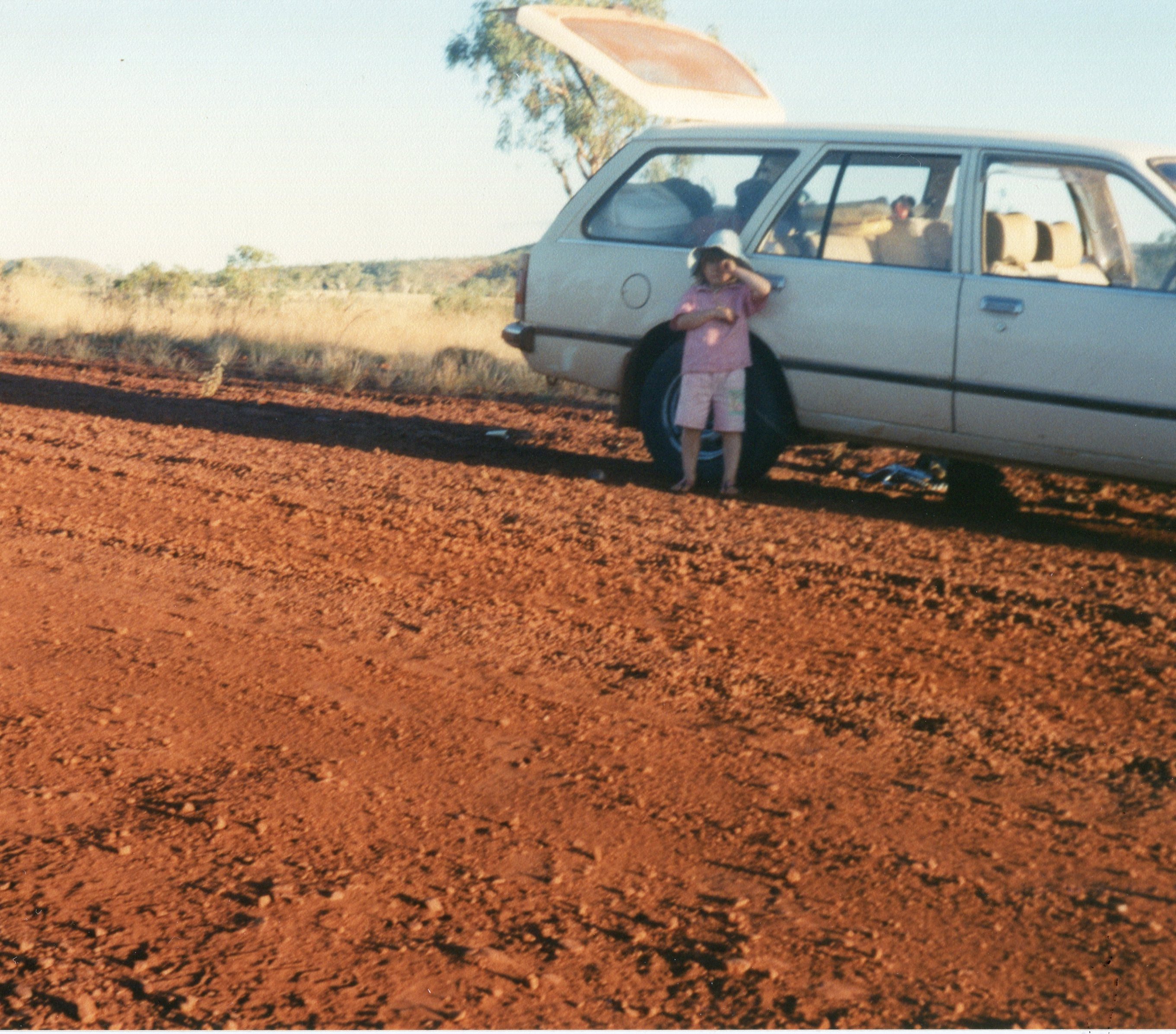
Anja - and car awaiting repaired tyres - Rohan took this photo with the kid's Olympus trip camera.
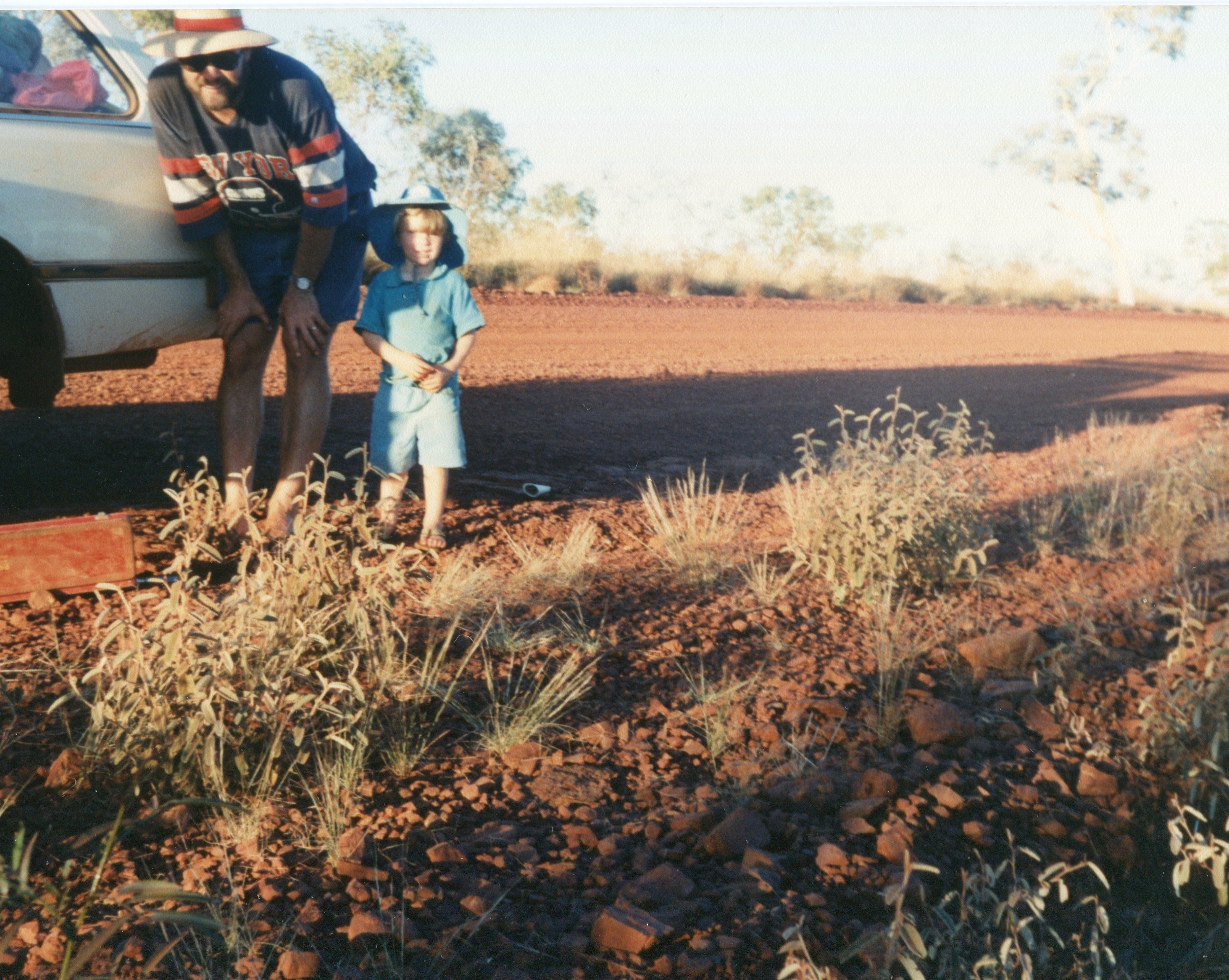
Ian and Rohan, taken by Anja.
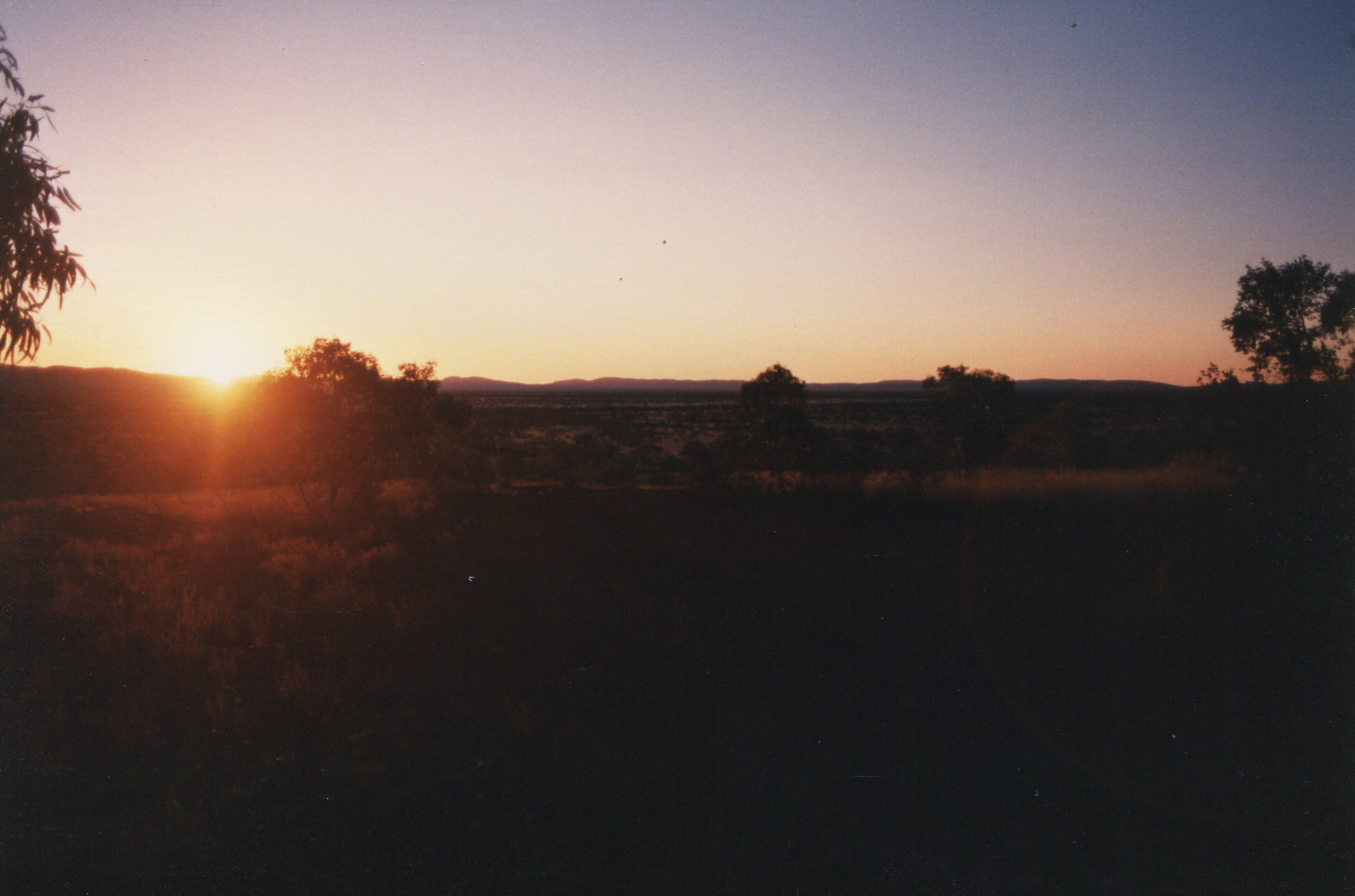
The sun went down while we waited for our tyres to be repaired. I note in the diary that the silence was amazing.
Just on dusk we were back on the road for the trip home, which was about 130 km. It took well over two hours as our speed reduced by the glare of the sun through a dirty windscreen and the ever present threat from cattle and kangaroos.
Dinner was welcome. We had Pizzas which we had partially cooked the previous evening and Sara Lee chocolate Bavarian Cheesecake.
To top off the day, one of the repaired tires was going flat again!
A Letter from Alison Anderson - June 1992
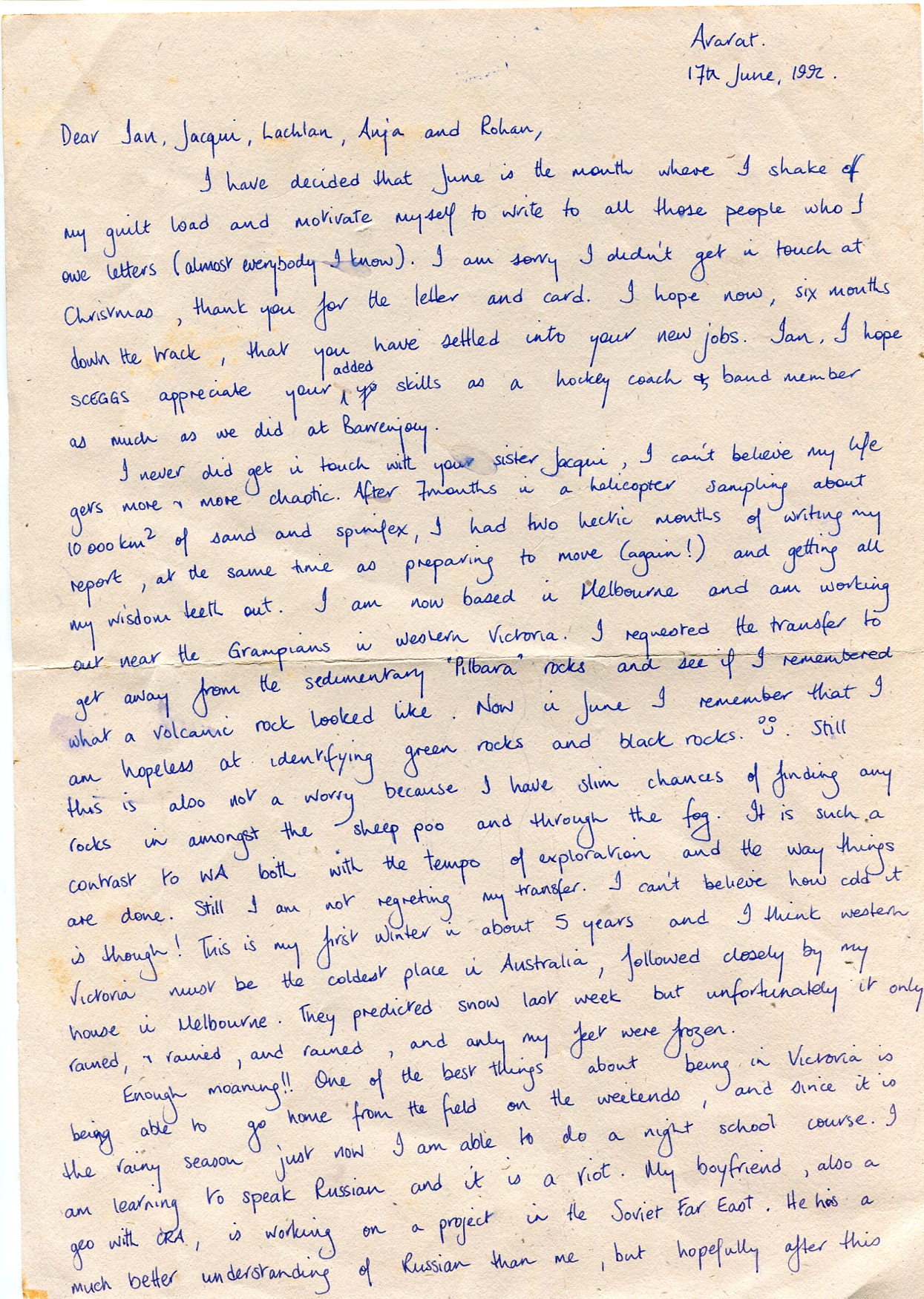
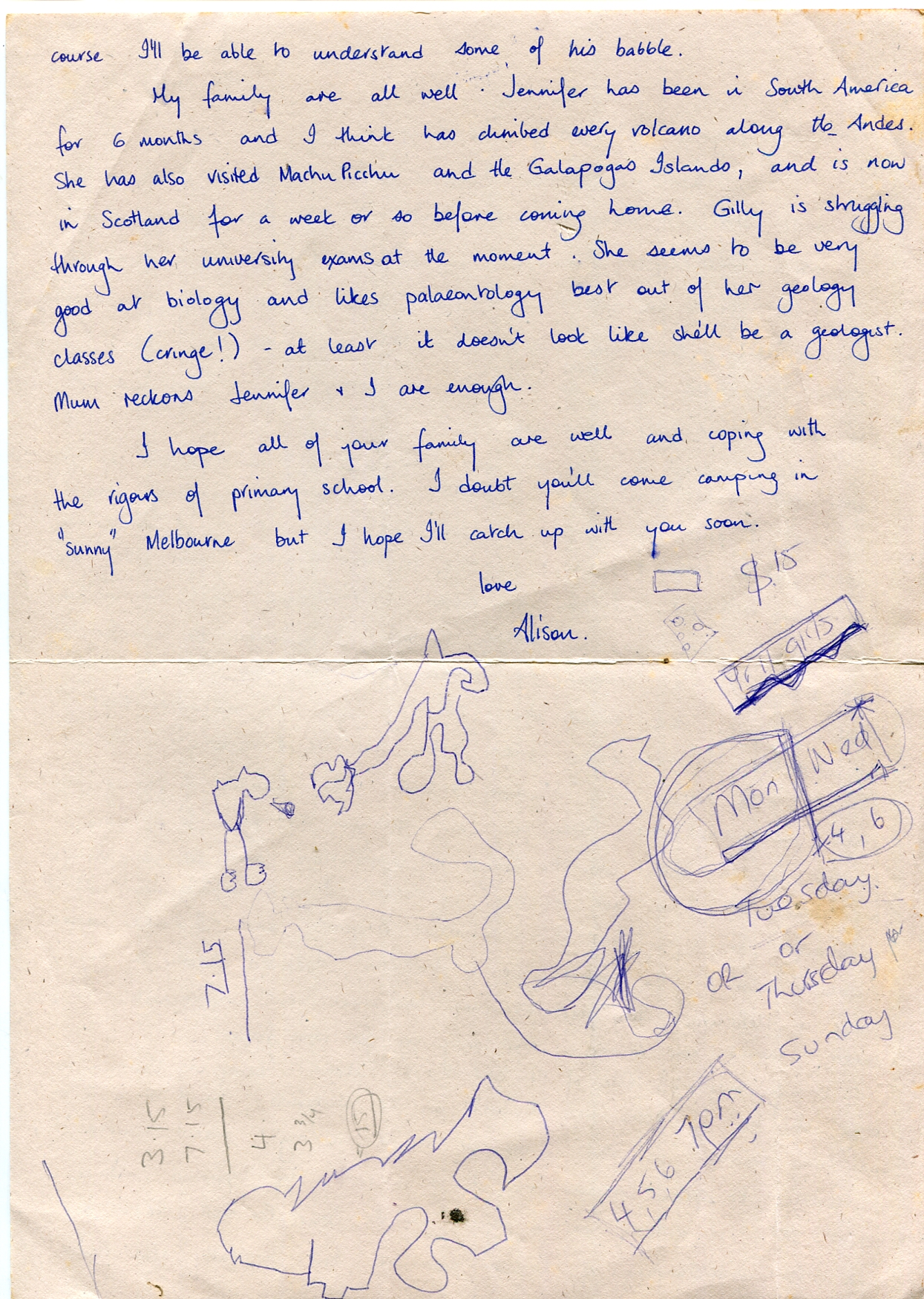
Sunday, 22 April 1990
As soon as the only garage in Tom Price opened at 8:30 AM, I was on the doorstep with a request to repair both tires. Had I not been tourist they said, I would have been out of luck.
However, the young men agreed to do the job. We soon found that one flat tyre had a large split and as a result was unrepairable, while the other might hold a plug. So, a new tire for $104 and an $8 repair for the plug saw us begin the pack up, which we did for what seemed like ages!
After lunch, prepared by Alison, we left at around midday. We took the railway access road that runs parallel to the railway line for the ore trains heading for Dampier.
What an amazing couple of days we had with Alison: she welcomed us into her home, got on so well with the kids and was an awesome tour guide with a deep understanding of the local area's geology and history. How lucky were we?

Just about to leave Alison Anderson's home in Tom Price for Millstream NP. I note in the diary under this photograph that the air suspension was flat again - adding to our flat tyre issues.
To stop road trains using this rail access road, and soon wrecking it, the mining company that owns the railway has placed barriers shortly after leaving Tom Price and again near the Wittenoom Highway. They look like this:
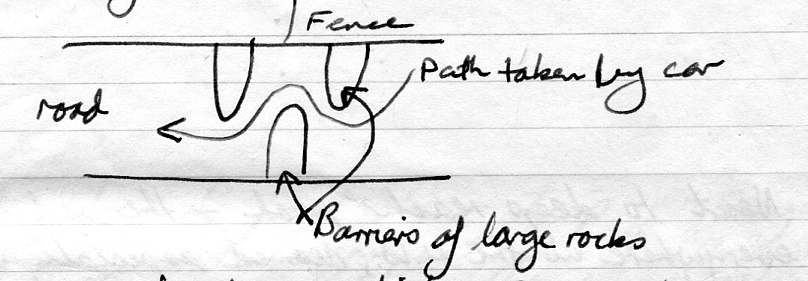
They stop, in theory, vehicles 8 m or longer. But our car and van must have been at least 8 m long! I’m not sure what we would have done had we managed to get half way through the chicane, before getting stuck. Backing out would have been a challenge.
Highlights of the trip to Millstream-Chichester National Park were the ore trains, of which we saw 2, both empty and heading back to Tom Price. When viewed from a moving car they seem endless, let alone when you are stopped watching them go by.
After turning off the access road, we found an excellent camping spot at Deep Reach pool. Here the aquifer an exposed:

The pool was steep sided and elongated, about 5 m deep in the centre. This made it difficult for Jacqui and me to let the kids swim unsupervised, as even we were unable to touch the bottom. Everyone managed to get wet though, which soothed some frayed tempers!
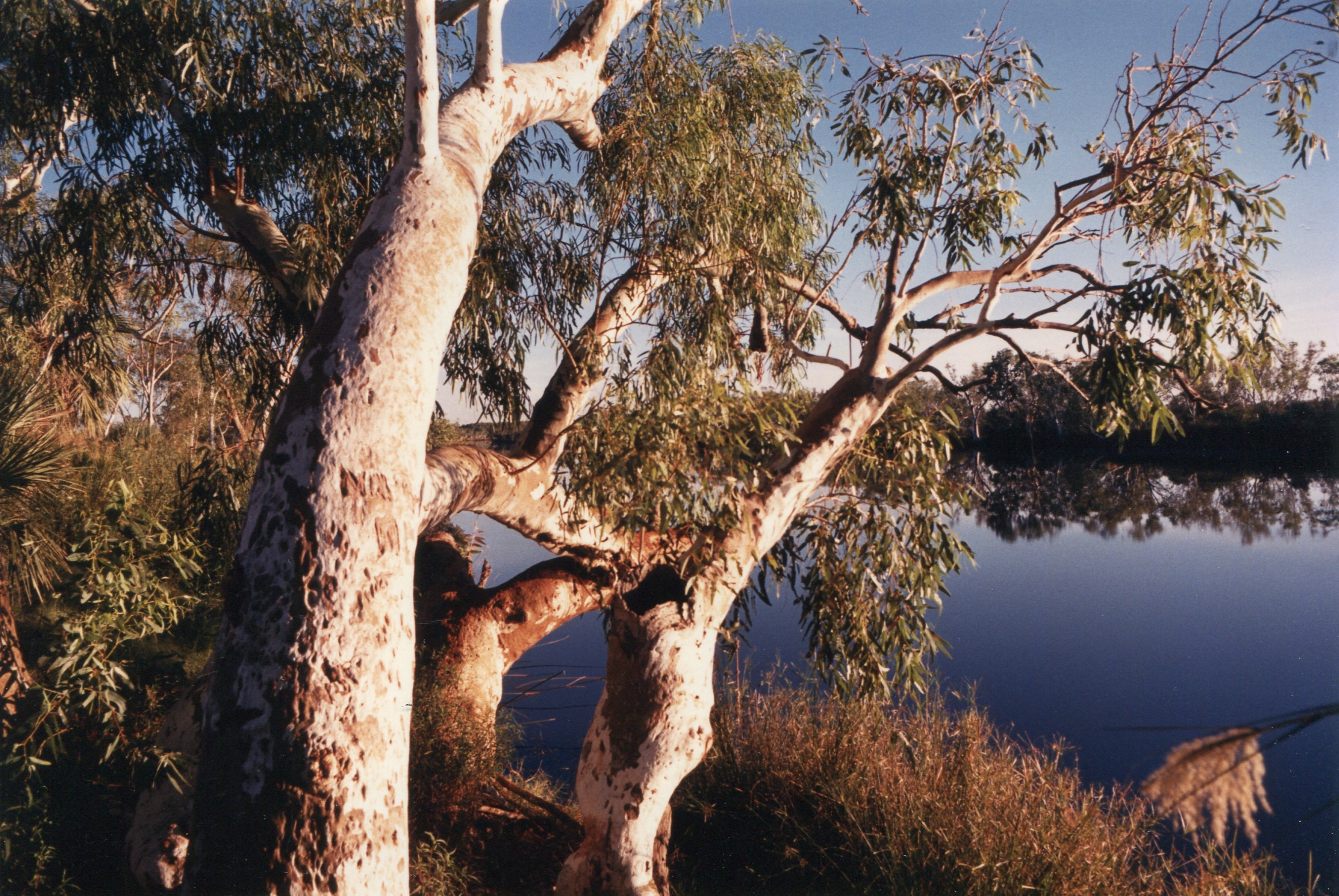
Our campsite at Millstream N.P. next to Deep Reach pool. Beautiful!
At the campsite, right next to the pool, we had our own table and a significant area of ground covered with a fine-grained red dust. Even though we had laid out the blue poly tarp, before long it and nearly everything else we possessed was covered in red dirt-especially the kids.
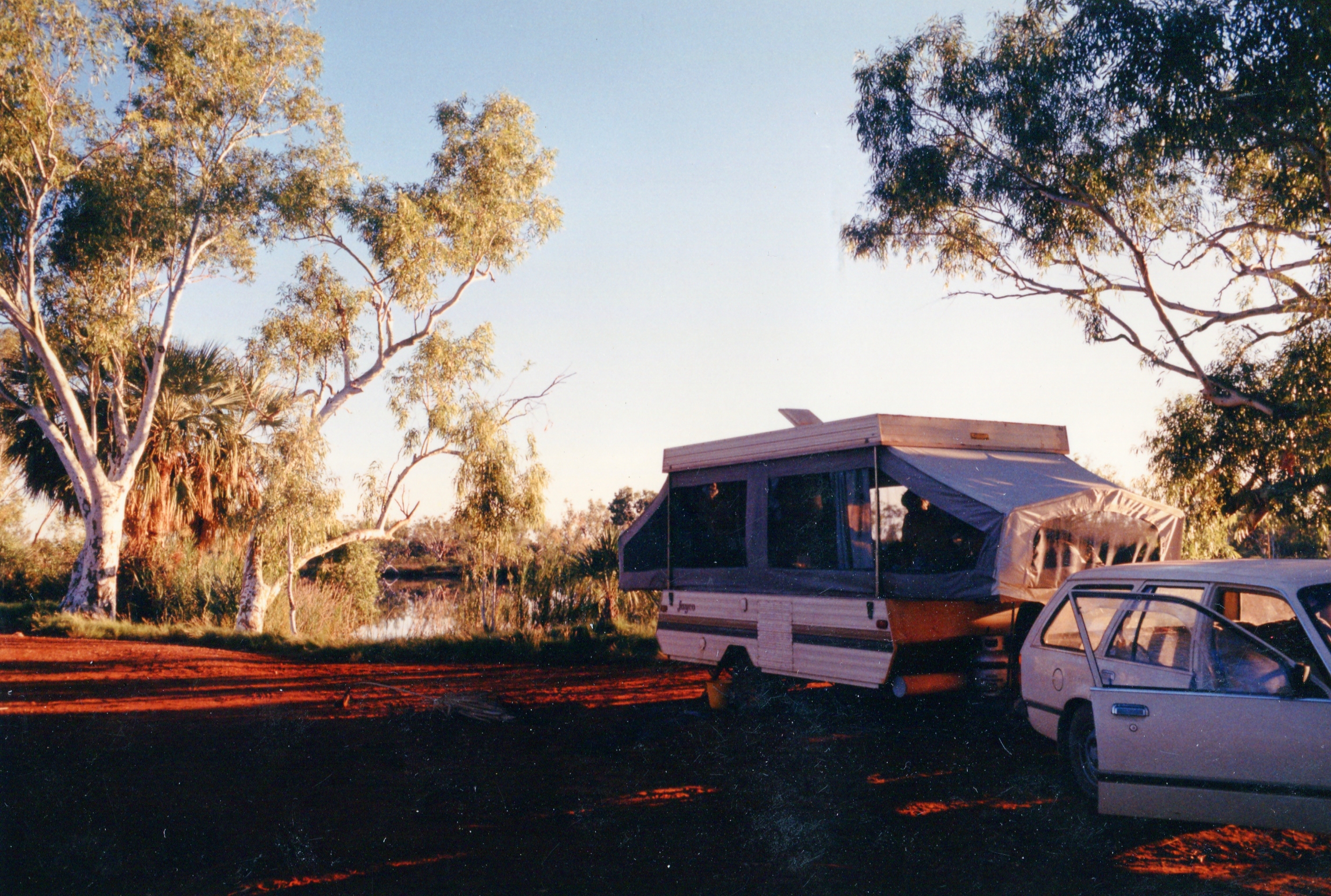
After an early dinner, we started to travel 5 km to Millstream Park headquarters to make our usual Sunday telephone calls. These were especially important as mum and Dad had returned from their trip to Singapore and Darwin and were to fly out for the United States on Tuesday, to spend time with Ian's sister, Karen. Without the caravan in tow, a clunking-rattling sound in the front left wheel became frighteningly loud. A quick inspection revealed the front left wheel would move 4-5cm laterally and emit said noise. We decided it was better to leave the calls until I could look more closely at the underlying caused of the wheel problem. Of course, the tyre repaired that morning had gone flat!
Monday 23rd of April 1990
During the night, which had started out hot, we found it necessary to pull over the doonas as it became quite cool.
Worrying about the car, I was eager to get a look and find out what the problem was, also an early start in the cool of the morning would make the job more pleasant-whatever that job might be.
The problem turned out to be a loose nut which holds the damper unit into the body of the suspension strut. Getting it to do up again was not easy as it was necessary to press the wheel inwards so that the damper unit was exactly in the centre of the suspension unit. In the end I used a palm tree and a hydraulic jack to push on the wheel as shown in the diagram below:
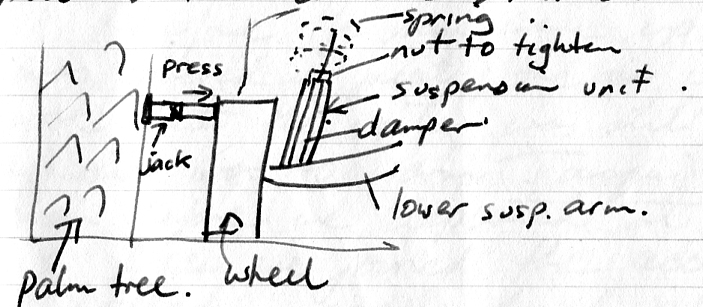
The job completed, we visited the actual Millstream National Park headquarters and the pools and dams which are part of the old station homestead. Here we saw beautiful waterlily filled pools, date palms and lots of resident fruit bats(flying foxes).
The aquifer is the source of water for Karratha so it came as no surprise to see a 30 cm diameter pipeline head off to the north-west along the road. We followed this for 3-4 km to where it forwarded the Fortescue River. Here was the ideal spot for the kids to swim, a shallow pool about 30 m² and well shaded to boot.
In fact, this is where we spent most of the day, with a short break for lunch back at the caravan.
Before leaving the swimming pool, I was forced to swim downstream through muddy reedbeds, to retrieve Anja’s kickboard which had floated through the pipe under the road.
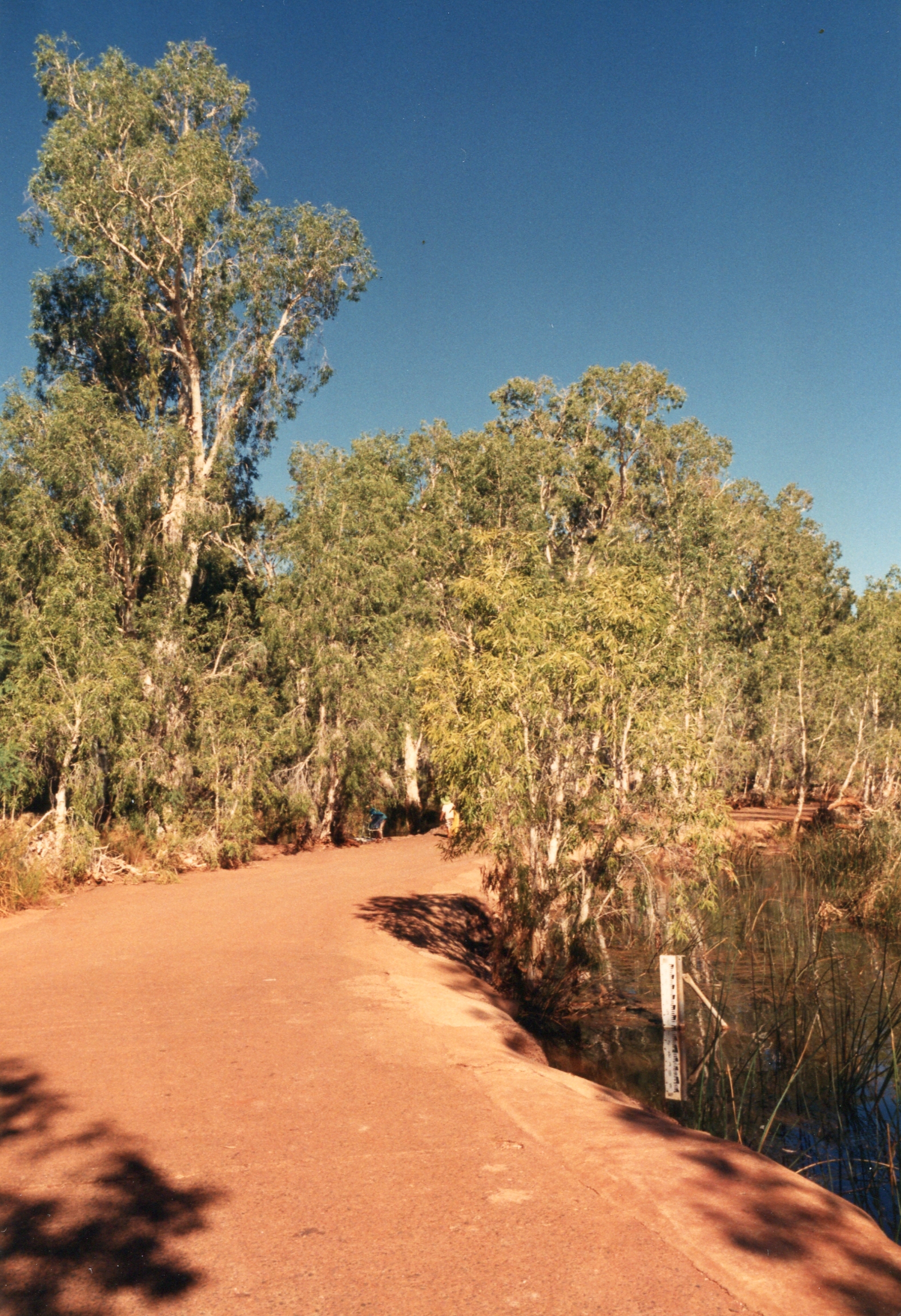
We spent many hours swimming in the Fortecue River beside this ford. Millstream National Park
Just on dusk, we called Mum and Dad to be told that "I would have been disinherited had I not called that evening"… Phew. [2020 note: My guess is that they were worried about us when we did not call in as usual on Sunday evening and to add to their concern, they would not be contactable from Tuesday. Remember this was in the days before email, SMS, and other social media. An international telephone call was very expensive and difficult to do from a coin pay phone.]
Tuesday 24th of April 1990
Before the sun came up, Deep Reach pool was covered in mist; the air was still cool, but the water was warm. The water was so warm, in fact, that Jacqui even went for a swim before we departed at 10 AM.
Again, we joined the access road, but travelled slower and more cautiously than we had on the previous day as our spare tyre was flat. Consequently, the 120 km trip to Karratha took close to 3 hours, the road being winding and rough in places. We had one adrenaline pumping moment when we crested a rise to see a huge truck, about 200 m ahead, on our side of the road. As we had nowhere to go, I was pleased he decided to return to his side of the road, leaving us covered in a cloud of dust and our hearts pounding!
Further along, was a comic sign, with a serious intention. On a huge rectangular board were the following: 60 km/h; winding road; steep descent; slippery road; with a statement underneath declaring You Have Been Warned!
At Karratha, we spent most of the afternoon shopping before setting up camp in a local caravan park.
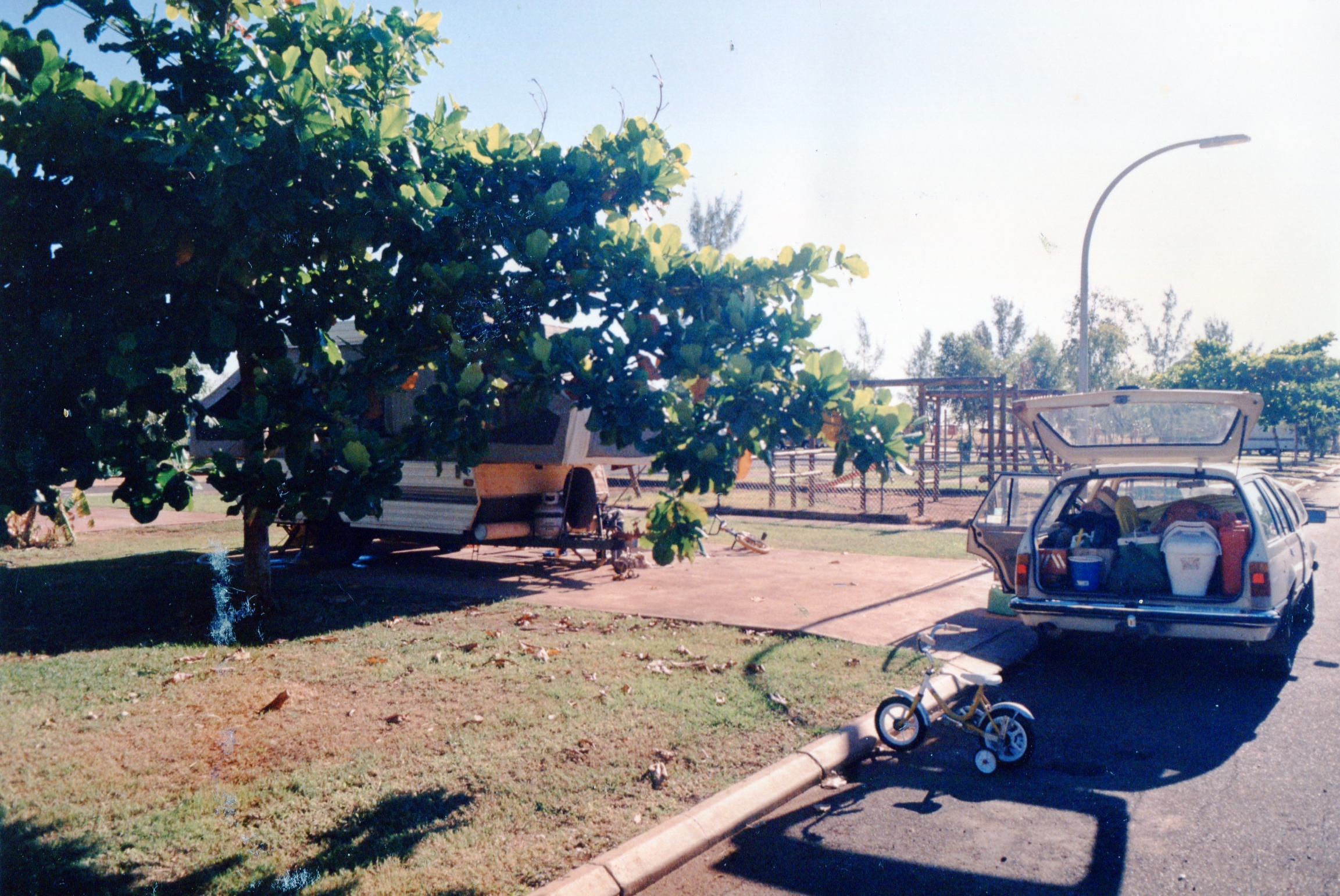
Grass and a concrete slab at the Karratha caravan park made a welcome change from our usual WA campsites with their red dust.
Wednesday 25th of April 1990-Anzac day
The sun poured into the van and it soon became too hot to stay in bed. So, making the most of the moderately cool morning, after a breakfast of Vita Brits and toast, I started work on the car. Firstly I replace the air filter and spark plugs, put in new headlight bulbs (55-100 W instead of 55-65 W). Next I replaced the airlines to the air suspension units and repositioned the T-pieces to a much less vulnerable position in the spare tyre Bay. All this was finished by 9:30 AM when, after a shower I enjoyed a cold beer with our neighbours Philip and Paul. [2020 note: I recall being surprised at the time that anyone would offer a beer at 9:30 AM, but I remember that, on this occasion, I was grateful].
Philip’s wife and kids are travelling around Australia, while Paul is a teacher at Port Hedland TAFE. He had resigned from his job as a technician at the SEC in Melbourne to move to Port Hedland - not something we would consider.
While I was working on the car, with my tools laid out around me, I was approached by a fellow camper. Apparently, as they were driving along, they had run into a sulfur crested cockatoo that had become lodged in the front of their vehicle. The poor bird didn’t die immediately, and before it did, it chewed through the coaxial cable leading to their CB radio antenna. I was able to offer my 12 V soldering iron so that they could fix it.
After some lounging around we went into Karratha to the swimming pool where we spent from 11 AM until 2:30 PM keeping cool.
That afternoon I washed the car and caravan, keeping as wet as possible. The water’s mineral content is so high that everything is soon covered with a white “stuff”, especially the glass. But at least we know what colour the car is, and it isn’t red. This dust has even penetrated our toenails, so they appear similarly coloured.
After dinner we again went to the pool.
Thursday 26th of April 1990
Another monotonously fine hot day to move, this time from Karratha to Pardo which is about 140 km north of Port Hedland.
The trip went without incident, the car towing the van better now that the air suspension is back to pressure.
Worthy of note along the way, near Karratha, were small hills partially covered by spinifex with a jumble of rocks on their top - like the volcano experiment with potassium permanganate. This dark brown, highly fragmented rock was a distinguishing feature of the area.
At 12 PM we were near Port Hedland and the kids were starting to get ratty as it was really hot in the car. Our first sight of Port Hedland through the shimmering heat haze were huge stockpiles of iron ore and associated loading equipment. Not far to the north of the iron ore stockpiles was an almost equally high stockpile of salt.
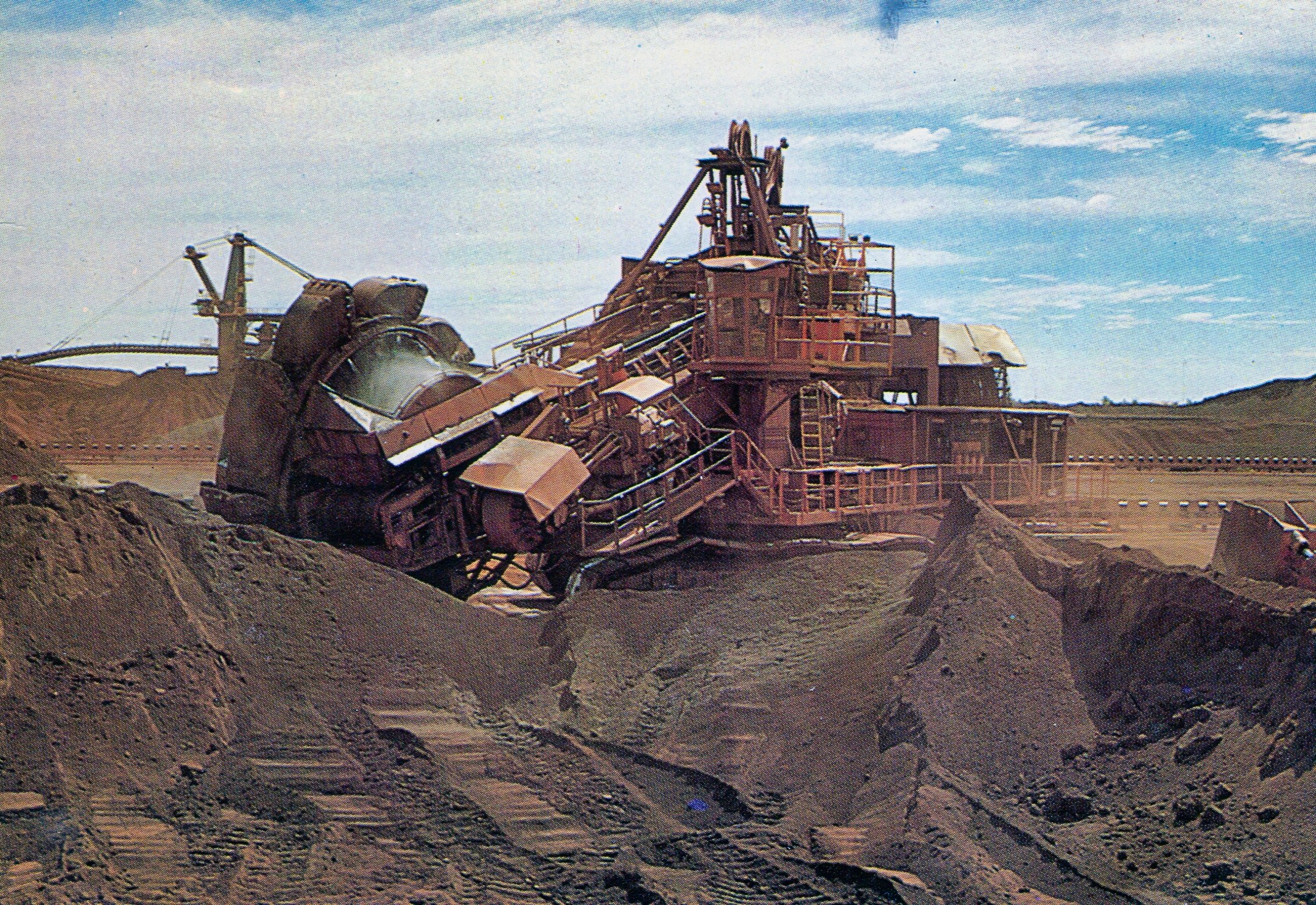
As well as piles of sea salt drying in the sun were piles of iron ore delivered from Mt Newman by train. Here the ore is transferred to ships for export.
We spent most of the time at Port Headland in the pool, sitting in the shade under a permanent fibreglass umbrella. The kids had a ball.
By 3:30 PM it had cooled a little and it was time to move on. Still hot in the car, we at least had the sun behind us, as we left the red dust-covered town behind.
[2020 note: Making news as I was transcriging our diary was controversy about the compulsory purchase of many properties in Port Hedland due to the pervasive and damaging red dust from the iron ore stockpiles - the reason we did not stay there overnight.]
Just after sunset we turned off at Pardoo to travel along 14 km of dirt – having washed the van and the car I was not sure why I had bothered washing them at all. We camped near the sea. [2020 note: most likely near Cape Keraudren which is the northern end of the rabbit proof fence. We probably didn't notice the fence as we arrived in the dark and we left early the next morning]
As soon as I got out of the car, the first thing I noticed, besides the rattle of the generator from a nearby Council workers camp, was the humidity. At 90% humidity and 30° C you could hardly not notice!
Jacqui went investigating down to the empty bay - the tide was out and came back bearing tales of oysters. The kids and I gathered a bowl and oyster knife, only to discover that the oysters were too small to eat.
On the way back to camp we captured a hermit crab and returned it to the shore. Just then Anja yelled ”snake snake” and jumped back. Sure enough, we had nearly walked on a small brown coloured snake, with a black head [2020 note: probably a deadly western brown snake]. Fortunately, it left quickly!
Later we discovered numerous hermit crabs prowling around at least 50 m from the sea.
Friday, 27 April 1990
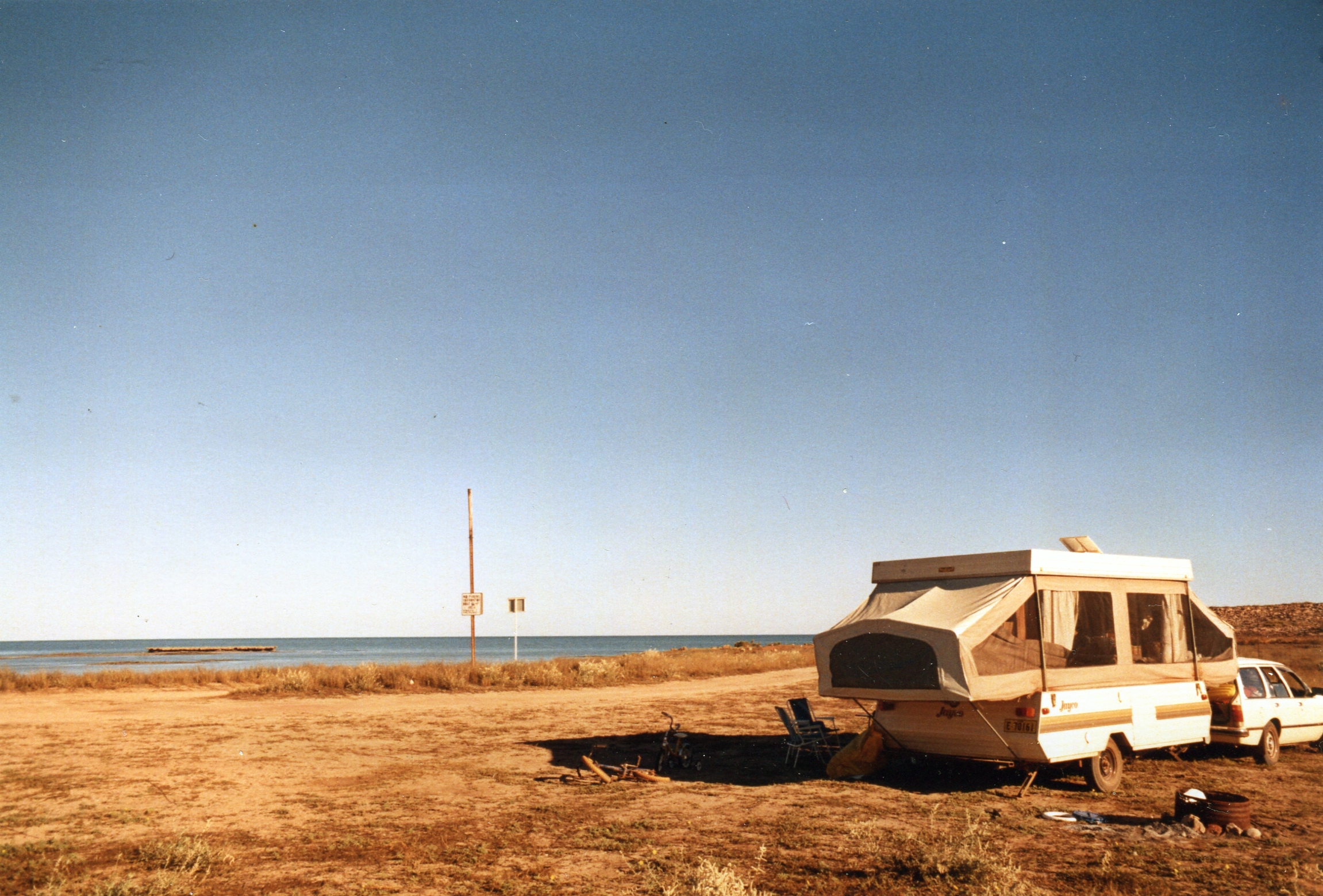
Our campsite at Cape Keraudren where we were visited by hermit crabs
Once again, we were up with the sun, but it was 8:30 AM before we left. Jacqui walked out on the mudflats looking for things potentially edible but returned with an empty razor shell and fingernail shell. The kids and I on the other hand were seen as edible by a small army of sandflies, so we retreated to the van for aeroguarding.
On the road we bought ice and lemonade at the Pardoo roadhouse. Even relatively early it was hot in the car as we began the 440 km trip to Broome.
We spoke on the CB radio to a truckie who delivers the concrete cladding used in local houses. Stuart and Melinda’s house in Exmouth is an example of a house using that construction method.
Another truck had a tyre blowout about 1 km in front of us. One of his re-capped tyres lost its cap and it was all over the road in little pieces. I spoke to the wiry little truckie as he was changing the tire at the Sandfire roadhouse. He said that a new steel belted radial tyre for his truck cost $600 and that he keeps these on the prime mover truck. Once they wear out, he puts them on the trailer until the tread is bare, before having them recapped. Again, they stay on the trailer for about 40,000 km for $150. The driver summed it up: ‘one blowout consumed the profit for a trip’.
On we travel through flat, monotonous scrub, and the car got hotter and hotter as the sun reached its zenith. Outside the temperature was 35° C and inside, who knows?
Finally, the road turned left and the tourist signs sprang up out of the red earth. We were in Broome!
That Broome’s major industry is tourism was highlighted by several things. Firstly, 2 jet aircraft arrived at the same time we did. Secondly there are numerous of tourist shops and as many pubs. Thirdly the post office attracted crowds of local and interstate visitors like a nectar filled flower attracts bees. Added to that it was 3:30 PM on a Friday.
We were at the post office to collect two packets of correspondence which had started life in Sydney Tasmania, travelled to Warrnambool, then to Robe, then to Eucla, then to Dunsborough and finally to Broome. Not surprisingly the post office person wanted to charge us extra postage of $10.15 for each package. Jacqui sorted them out and we paid only $8.50 in total. I suppose giving the second-in-charge a hard time about how slow mail deliveries are, in front of 50 customers at 3:45Pm on a Friday afternoon may have helped our cause.
So, by now, the kids and I were very hot and some of us were very bothered. After collecting money and food we slipped into the lukewarm water at Cable Beach. Well, that was after we walked over 150 m of sand flats to reach the water - the tide was out. Leaving lots of tracks in the sand were snails and, feeding in the water draining into pools around the exposed sand, were many fish that looked like whiting.
After setting up camp and feasting on crumbed calamari rings that Jacqui didn’t catch, we were alarmed by a flash in our caravan. The power to a big section of the camping area switched off at the same time as the flash. We found, after due interrogation, that Anja had slipped the lid of a tin can in between the plug and power point, shorting the active and neutral pins. After this the tin lid had 2 charred indents with big chunks missing. We were truly fortunate that Anja was alive to tell the tale.
Saturday, 28 April 1990
The kids and I spent the morning in the pool, while Jacqui attacked the washing and went into town to do the week’s shopping.
Upon her return we changed and went to the Cable Beach club for an excellent meal of Indonesian food. The club itself is built from galvanised iron, red timber and green lattice with a distinctly Chinese feeling. The waiters and waitresses were done up in green floral shirts and whites. We even scored a free carafe of lemonade as the waiters brought us lemon squash instead of lemonade. The whole meal cost about $50 which was not bad for the best food we have had in months. Thanks Tracy and Clive Swatton for recommending this place.
The remainder of the afternoon was again spent in the pool, even though we had planned to go out. Lachlan is swimming so well - not in terms of style, but he is capable of swimming underwater for significant distances and will fearlessly jump into the deep end of the pool. Anja copes equally as well with a black floaty and kick board, swimming all over the pool confidently but safely. Rohan tends to be content to sit on the edge of the pool after getting wet to cool off.
Sunday, 29 April 1990
Lord McAlpine owns numerous pieces of property around the world, two of which are the Cable Beach Club and the Pearl Coast zoo in Broome.
Before heading to the zoo, we took our time packing up so that a clothesline full of washing could dry and the heavy condensation on the annex could evaporate
We got to the Pearl Coast zoo at around 10:30 AM - family entry cost $26.
The zoo has an extensive bird collection with numerous roomy aviaries housing many local birds as well as endangered species from overseas. This seems to be the rationale behind the zoo: to house and preserve endangered species. Included things like the greater kudu, cheetah and African water buffalo.
Probably the most unique feature of this zoo was the elevated, 1.3km long, “U” shaped walkway allowing a bird’s eye view of the large animals. The cheetah was seen closeup and from the different perspective of the walkway - lying in the shade underneath. This was the first time I had seen this animal at such close quarters.
Strategically placed along the walkway were palm-thatched rest areas, a good idea as we were there at nearly the hottest part of the day.
After an early lunch in the mottled shade of a palm frond shelter, and a further inspection of some magnificent macaws, it was off to the Broome historical museum. Unfortunately it was closed!
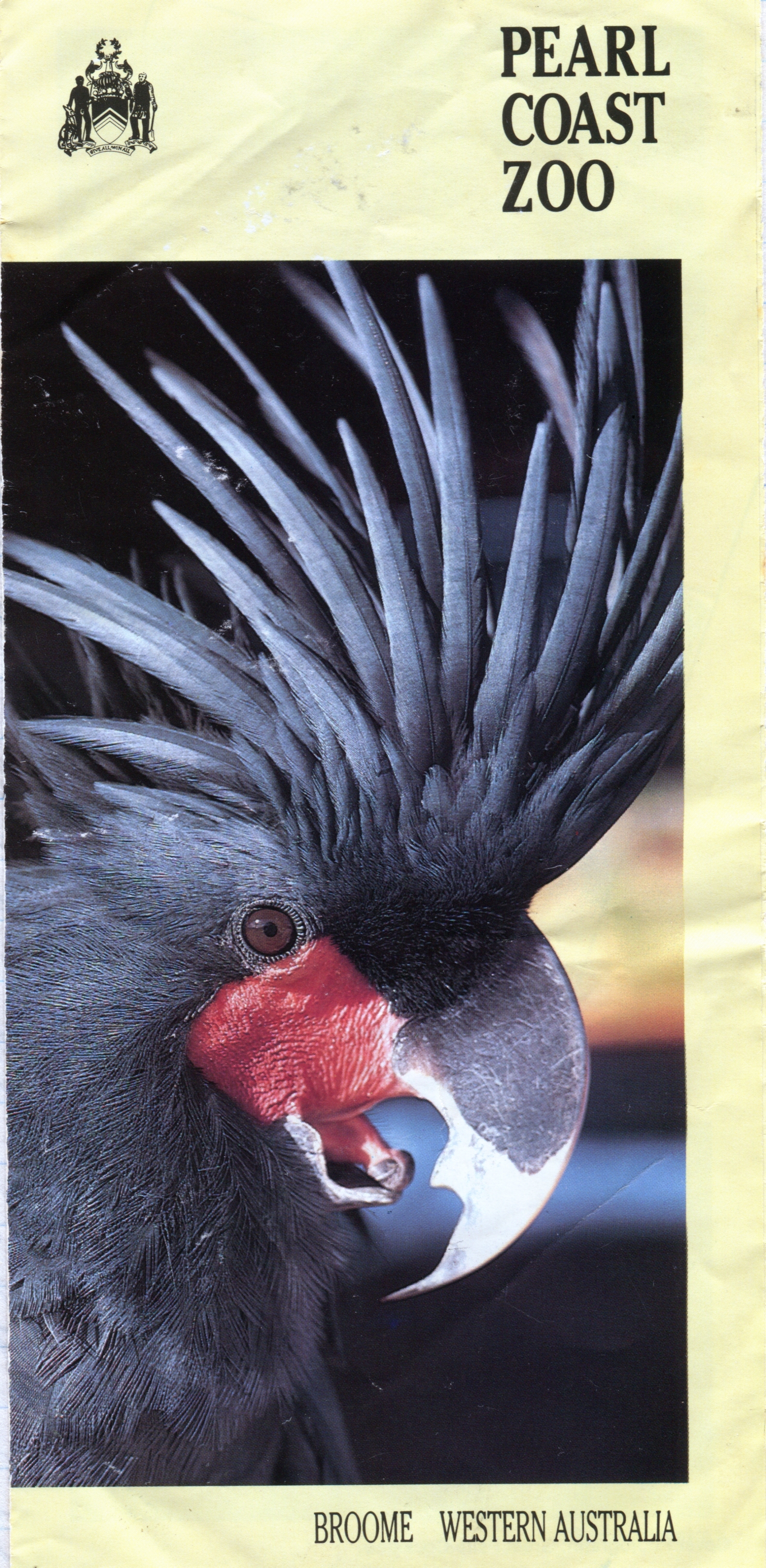
So, instead of the museum, we headed for the Broome Royal Australian Ornithological Union Bird Observatory. After 15 km on a rough sand road we found that this wasn’t the right time of day for bird observations! Our consolation prize was a few pamphlets.
Bumping back to the main road, where I had to replace 2 lost shackles on the emergency chains connecting the caravan to the car (I must have forgotten to tighten them when last attaching the caravan to the car), we were on our way to Fitzroy Crossing.
Fitzroy Crossing was not our planned destination, but the lack of suitable rest areas at which to camp meant that we had to drive after dark. Everything was going fine, until the lights went out! This was especially concerning as the road was unfenced and lots of cattle were wandering nearby and on the road. I’m not sure, but I suppose the extra current drawn by the new 100W halogen hi-beam bulbs, destroyed the high beam switch. The fuse was okay as low beam still worked. So, at a reduced speed, we pulled into the Fitzroy Crossing Park at around 9:30 PM, having covered 456 km since Broome.
Monday 30th of April 1990
The facilities at the Fitzroy Crossing caravan park were awful, so we decided to pack up and move on. Our first stop was to be the Geikie Gorge where we had been briefed by other travellers to expect an excellent boat trip. Unfortunately, the Conservation and Land Management people had decided that the only cruise would be at 9 AM. We arrived at around 10:30 AM!
Whilst the average observer may not have noticed anything amiss with our behaviour, we were so browned off at having missed the cruise, that we managed to lock the keys in the car! Fortunately, the kids’ windows had been left open and with the help of a road construction worker and a length of fencing wire, the door was eventually unlocked.
Without the pleasure of seeing Geikie gorge we headed off to Halls Creek, after a lunch of sandwiches and cold lemonade.
The trip of 288 km took close to 4 hours to complete. Our top speed was reduced by a nasty headwind, and the high temperature of the early afternoon meant stops for refreshment and rest and recreation were frequent, not that there are any roadhouses.
The scenery was excellent, changing constantly as the rock type and its structure varied. Here we would see limestone that was heavily eroded and there would be BIF or massive red sandstone in stark relief to the false green of the ever present for Spinifex.
One of our stops wasn’t voluntary. Just as a Bus Australia Coach passed us, we had to fix a flat tyre on the curb side of the caravan. My guess is that we pulled left as the bus overtook. This caused the left caravan wheel to leave the bitumen – the sharp edge of which punctured the tyre as the van returned to the road proper.
After changing the tyre, the eventful trip was nearly over when, with Jacqui at the wheel and me buried oblivious in a book, a helicopter descended and flew slightly above and to the right of us. The chopping sound of the rotors was very loud, and we could clearly see smiling occupants in the helicopter. A little too slowly I dove over the back seat for the video camera which then let us down by refusing to focus (the second time this has happened). Jacqui said that at first, she thought a road train was about to overtake us as the sound of the chopper approached from behind. Then realising it was a helicopter, she thought it may be the police attempting to pull her over for speeding. This hypothesis was quickly dismissed - there was a headwind and our Commodore is gutless.
The kids were, of course, delighted with our travelling companion.
After booking into the Halls Creek caravan park, we organised for an early morning flight over the Bungle Bungle National Park.
For refreshment that evening I visited the local pub and bought some low alcohol EMU beer: 24 cans for $26. The public bar was a starkly bare room with all windows meshed and the few not meshed were broken.
At Geikie gorge we had spoken to seven girls and one guy from Scotland - fellow travellers - who were having difficulties with their Combi. We met them again at our Halls Creek Caravan Park and spent the evening chatting, drinking beer and port.
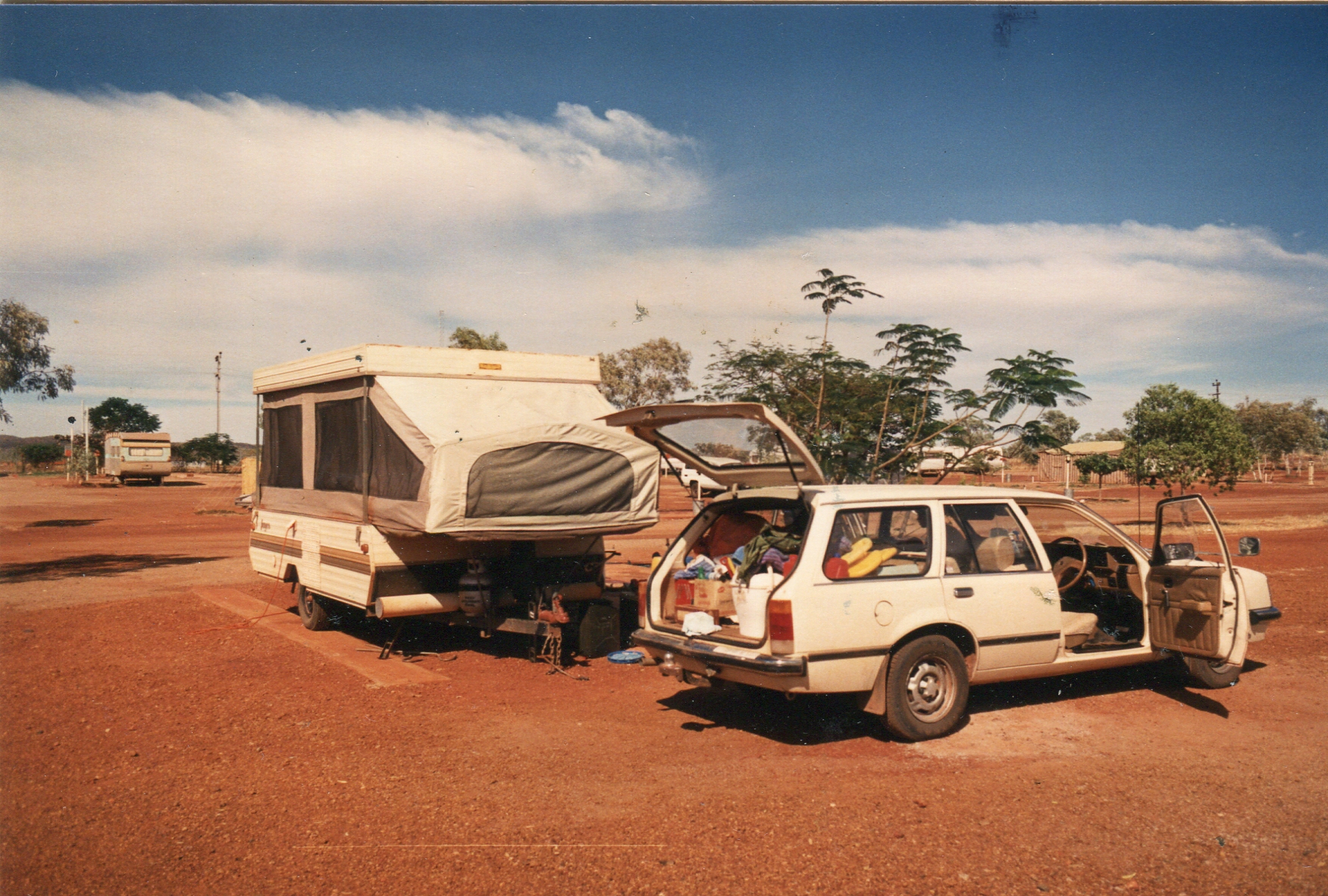
Our Halls Creek campsite had the red sand and dust of NW WA, but the concrete slab on which we setup kept it mostly out of the van. Not much in the way of shade, though!
Tuesday, 1 May 1990
Having borrowed an alarm clock and set it to go off at 5 AM, I was less than happy that it beeped at about 4:30 AM and I couldn’t reset it to give me half an hour more sleep. Anyway, we were ready to be picked up at 5:45 AM for our Bungles flight.
15 minutes later, Nigel our 24-year-old pilot and bus driver, collected us in a Toyota van and drove us the 200 m to the airport.
First, he briefed us on our flight plans over the Bungles and then, we hopped into the single engine Cessna, which seated the five of us plus pilot with ease.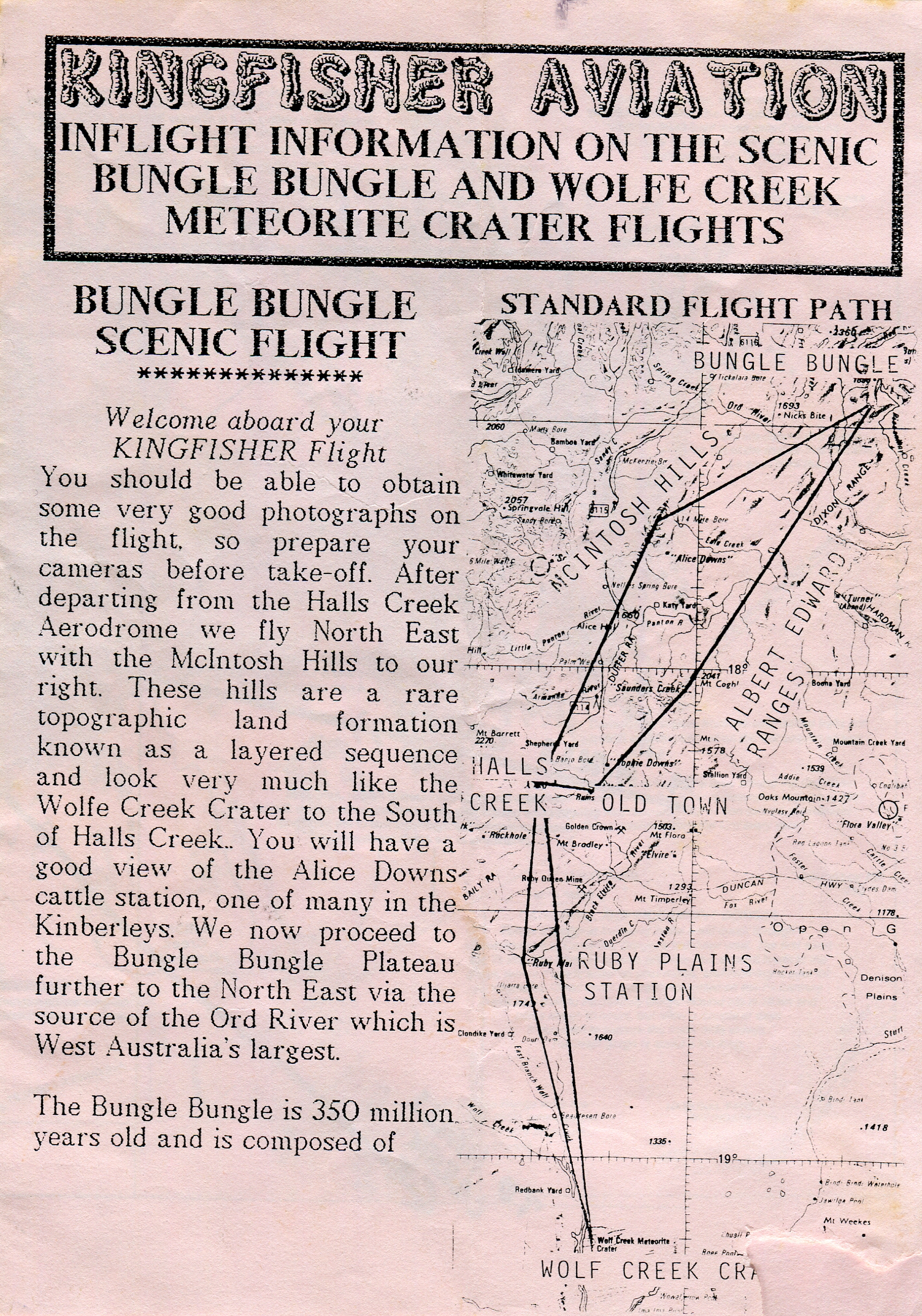

The one hour and 20-minute flight was worth every bit of the $255 (calculated as three adults at $85 each), we paid. From the air the variability of the countryside’s topography and its relationship to rock type and structure was readily apparent. In fact, the area is much more rugged than you would imagine when seeing it from a car.
On the way we flew over a structure similar to that which formed Wilpina Pound, used to stockade cattle in the olden days. The Bungle Bungle Ranges were splendid in the early morning rays of the sun, each beehive and gorge being highlighted by shadow. The natural reds and browns in layers alternating, exposed by the strange erosion pattern, was also strengthened by the early sunshine.
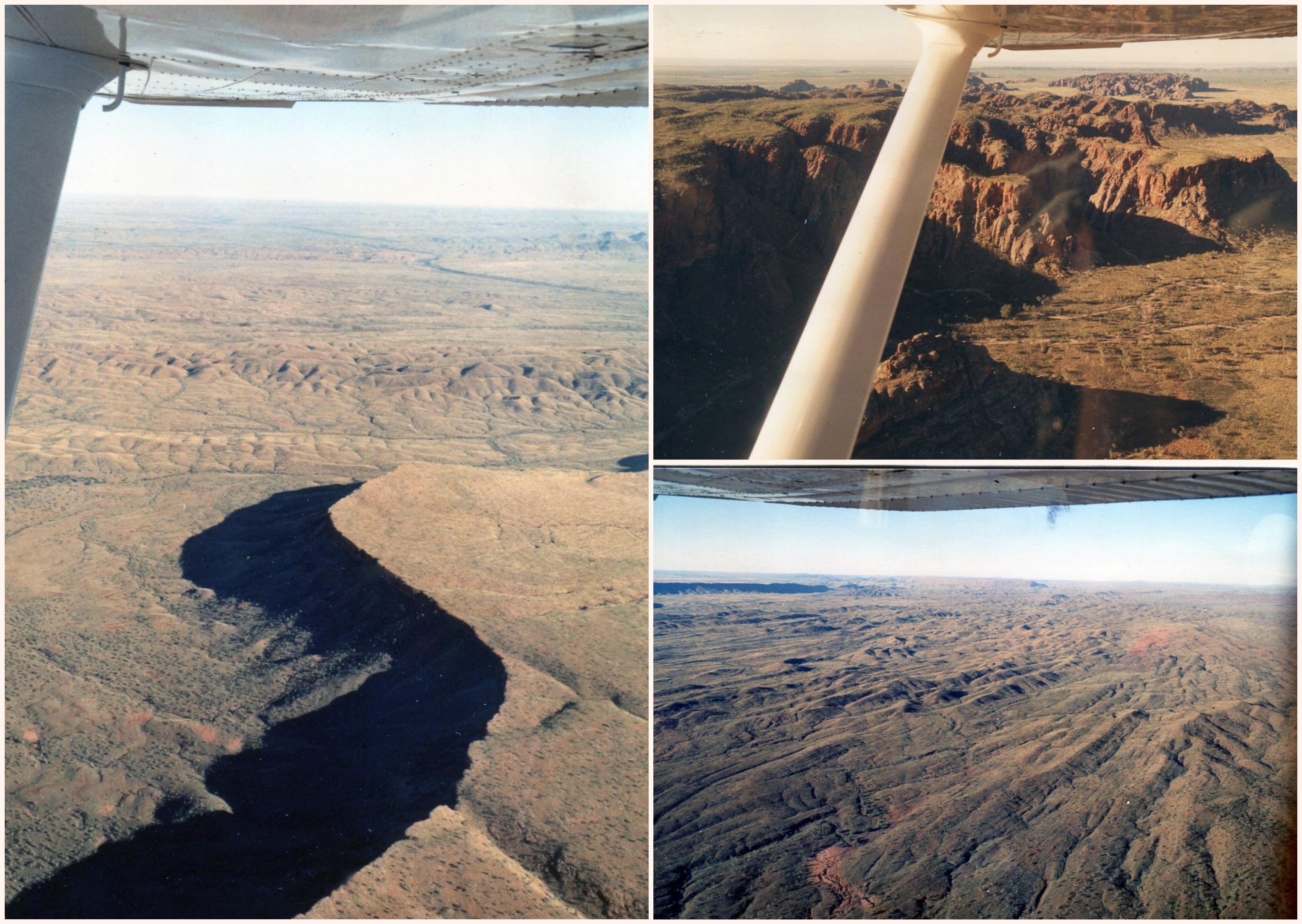
Our flight over the Bungle Bungle ranges left early in the morning. The advantages of our early departure were that the long shadows helped to highlight the landforms; there was less turbulence than later in the day (as you will see if you watch the video of our flight, it was still quite bumpy) and it was much cooler.
On the way back to Halls Creek Nigel let me fly for about five minutes, not difficult in a modern aircraft flying straight and level or when gentle descent is called for. Jacqui was not aware that I had been flying the plane and wasn’t very happy when she found out I had been at the controls!
Oh yes, I nearly forgot there were eight aircraft over the Bungles on this day. At the height of the season there can be as many as 40! The Bungles do not cover that big an area meaning that there are plenty of opportunities for mid-air collisions! Just as well our pilot was on the ball.
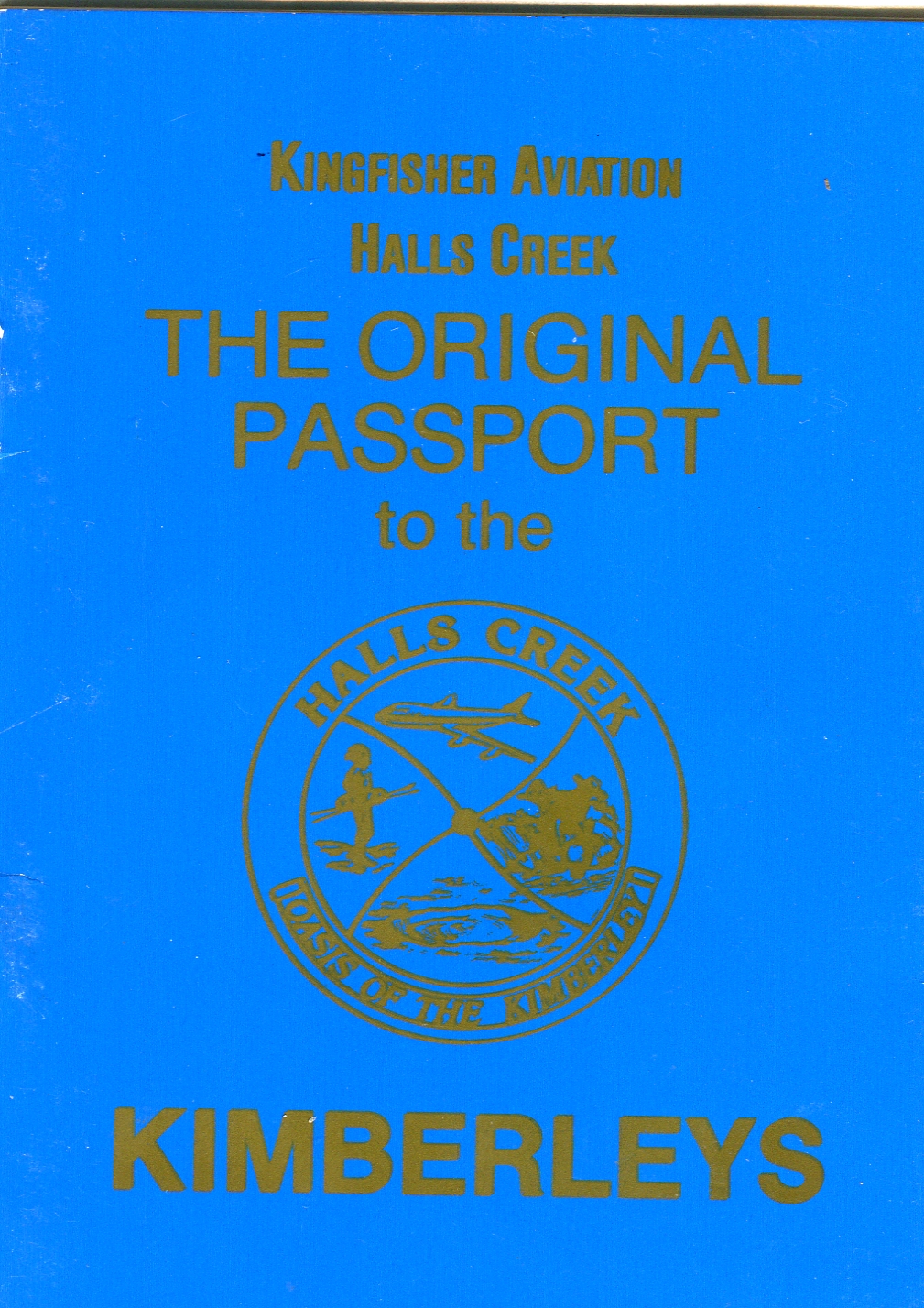
Also seen from the air were isolated cattle stations, a gold mine that has been recently closed, the old Halls Creek townsite that flooded in the wet and was bone dry in the dry, and a glimmering of a yellow haze to the south-east, the beginning of the great Sandy Desert.
Nigel had been flying for eight years, taking his first lesson on his 16th birthday. He was young, friendly and interesting. He was just back from four weeks in Queensland where he had been doing theory work for jet aircraft, hoping to score a job with one of the big airlines.[2020 note: an interesting career choice at the time given that nearly all pilots had been fired in the pilot’s strike that was on at the time]
As usual it was hot and cloudless. Being back by 8 AM, gave us a full day, so I fixed the car’s headlight and made temporarily repairs to the spare tire for the caravan, while Jacqui worked with Lachlan on correspondence school lessons.
After lunch we swam in the pleasantly brisk pool, read books and generally relaxed.
Wednesday, 2 May 1990
Yet another hot, clear day and yet another day of travelling, this time to Kununurra. As the road cut right through the Archean block of the Kimberleys, the 359 km trip was much more interesting than any part of the country since Perth, with the notable exception of the Hamersley ranges. Here the road twisted and turned, climbed and fell over the distinctly hilly landscape. The variation in rock type meant that the view was always changing and changing also was the type of vegetation as a result.
Jacqui wasn’t feeling well so she took Lachlan’s place in the back seat and I had Lachlan as my co-pilot in the front. Not long after lunch a rock, thrown up by a passing road train, hit and shattered the windscreen in the lower right-hand corner, making a loud bang and startling all on board. I was covered with fine shards of glass, two of which drew blood on my right leg. We were fortunate that the point of impact was well out of my line of sight and driving was no problem. We plan to have it repaired in Darwin. Check-out the video on Lake Argyle in the entry for 5th May to see the extent of the damage.
The tailwind we had most of the day helped us maintain a good average speed, and fuel consumption was down.
At Kununurra we spent some time shopping, where we saw some of the diamonds from the Argyle diamond mine. Uncut examples about 1-3 mm across, can be bought for 7 dollars (we surreptitiously bought a small diamond as a gift for Lachlan on his birthday.)
At the caravan park we were placed at the end of a row, next to permanent residents, all of whom had air-conditioners, all of which ran throughout the night providing white noise to blanket crickets and frogs etc.
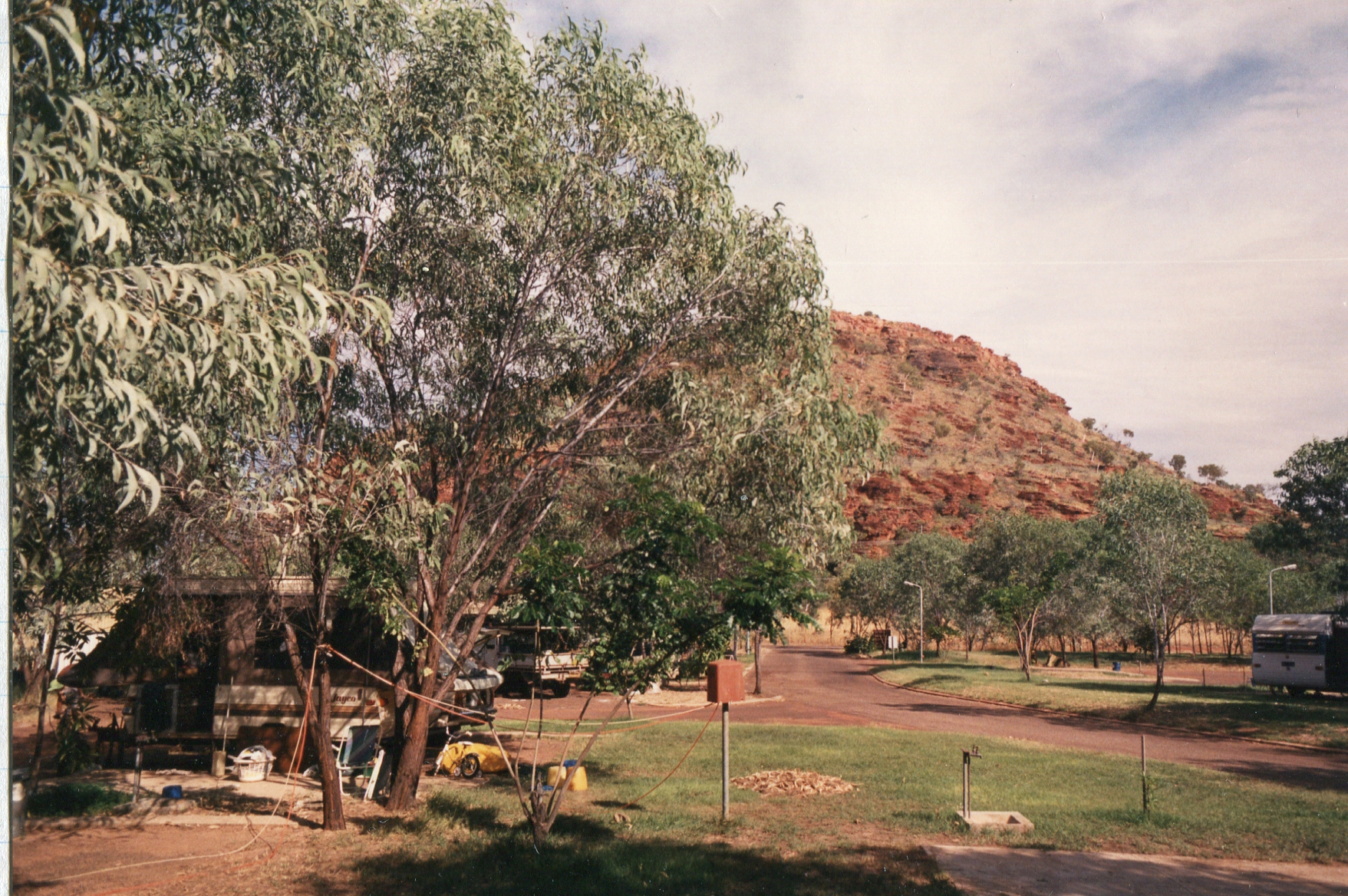
Our campsite at the Kununurra camping area was shaded by these trees in the morning and by the the hill in the background from around 4pm. Even so, it was hot.
Thursday, 3 May 1990
Until lunchtime I wasn’t well having a headache, stuffed up nose and I felt dizzy. So, we stayed at the van with me in bed. I suspect I had a touch of what ailed Jacque a few days ago.
After lunch of pies and pasties purchased in town, it was hot enough for a dip in the pool and some relaxed reading and writing.
Friday, 4 May 1990
During the morning Lachlan did some correspondence, Anja and Rohan played with some friends up the road and I wrote letters and washed the car.
The afternoon was spent shopping and visiting some of the local attractions
Our first stop was Hidden Valley, literally behind our caravan park. It is a narrow, flat bottomed, mostly dry gorge, of interest primarily because of the pretty and interesting rock formations, aboriginal artefacts and weathering therein.
A short while later we drove up to Kelly’s Knob. This gave a panoramic view of the town and the Ord River irrigation scheme. We were there at around 4 PM, and looking West we could see the sun highlighting the dust of a car travelling along a distant dirt road. Although most of the valley was in shadow, the distant hills were brightly illuminated and displayed an intensity of colour only possible with such lighting.
From here we drove over the main irrigation canal to Ivanhoe Crossing, a causeway 20 cm under swiftly flowing water. A crocodile warning sign was clearly evident, apparently ignored by a pelican that was fishing intently in the turbulent waters immediately below the causeway. The proprietor of the caravan park was to tell us later, that good barramundi can be caught at this spot.
Taking an indirect route back to camp, we passed kilometre after kilometre of arrow-straight furrows with irrigation water succouring what appeared to be melon plants of some type.
Being the day before Lachlan’s sixth birthday we decided to celebrate today, which we did with a mintie hunt, cocktail frankfurts and lemonade followed by chocolate Bavarian cake.
Lachlan was pleased to receive all his presents, especially the Lego and books from Jo and Nicky and the car from Owie and Georgie.
I forgot to mention that during the morning we received some valuable tips on the Northern Territory and Queensland from retired couple-John and his Belgian wife.
Saturday, 5 May 1990 (Lachlan’s sixth birthday)
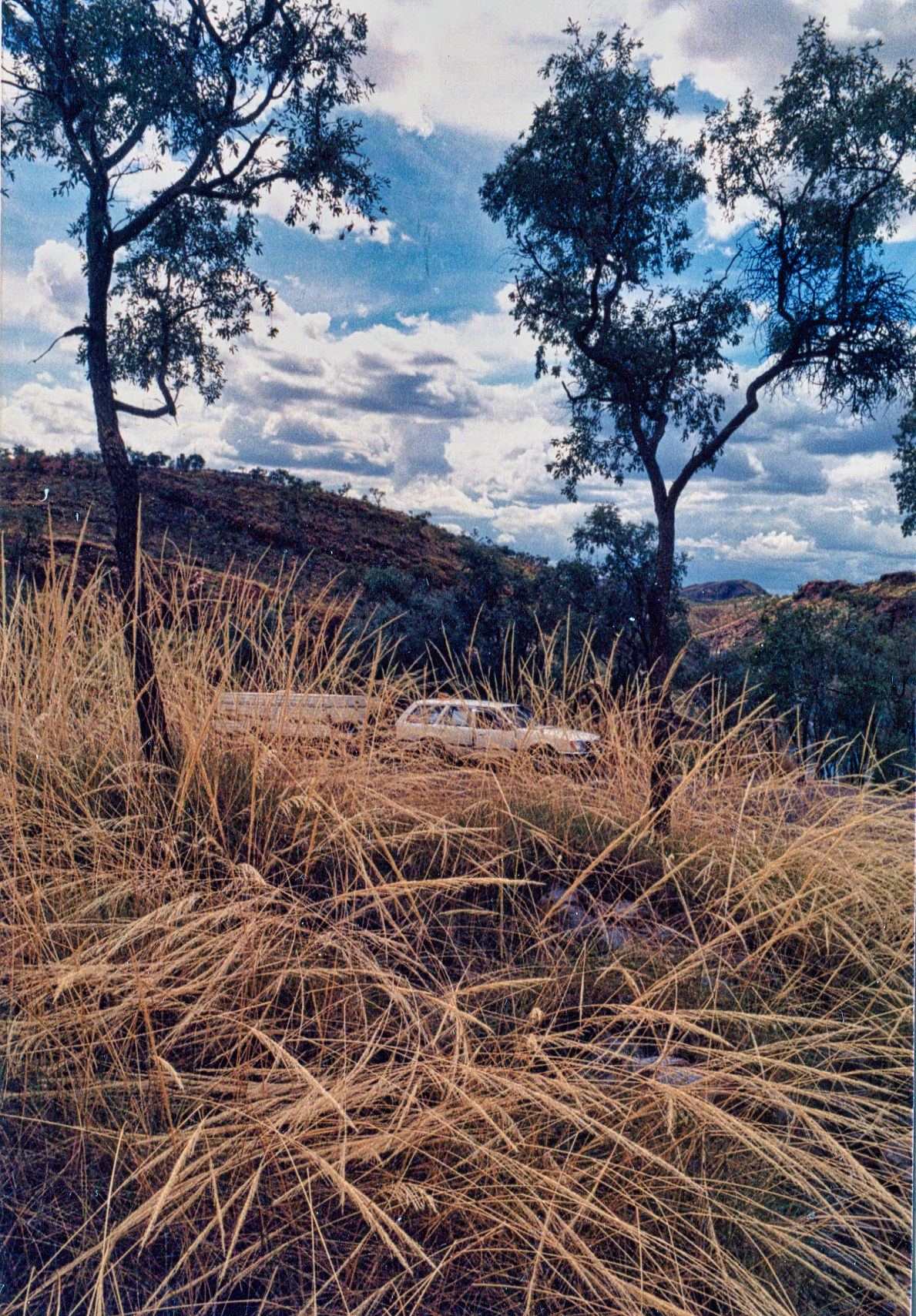
Spinifex was everywhere including here at the lookout over Lake Argyle
After refuelling and stocking up on bread, oil and cassette tapes we left Kununurra and headed for Lake Argyle. The dam wall is a clay core and is covered in rocks, damming the Ord river, between the closest points in the channel. The water released from the dam spews into the channel from three man-sized pipes with a roar easily heard 2 km away. The lake itself twists and turns around the red hills. From one vantage point, the lake’s waters, can be seen many kilometres away with that blue haze typically seen when looking over the sea.
T
As we travelled towards Timber Creek, the cloud cover grew from the odd fair-weather cumulus o more densely packed cumulus finally developing into cumulonimbus. Rain looks inevitable.

We'd travelled more than 5,500km fom Eucla on the SA-WA border to get here at the WA-NT border around 20km from Lake Argyle. I noted in the diary that "Yobbos had spoilt this sign".
About 10 km before Timber Creek we stopped at a free camping spot, but we decided to move to Timber Creek as the video battery was flat and we also had no way of being sure we could wake up in time. We’d put the clocks forward by 1½ hours when we entered the Northern Territory. Waking up early isn’t normally a priority, but we were intending to go on Max’s (not my uncle Max) boat tour which leaves Timber Creek at eight a.m.
At Timber Creek (a roadhouse, pub, caravan park and Max’s) I paid for our accommodation and then went to see about a tour with Max. Three kits you say. No way would they take three kids on a 3 ½ hour cruise with nowhere to go and lots to listen to. Fortunately, I was able to get our campsite money refunded and we continued our journey to Katherine.
About 10 minutes after passing Victoria River, the heavens opened. Thinking it was only an isolated thunderstorm we pressed on for about 30 km. But, with Katherine 170 km away, the single lane bitumen road crossed by flood ways, 10m visibility in the rain and with night fast approaching we decided to turn back to Victoria River.
At Victoria River I set the van up in the rain, which soon stopped. Later that night Storn and Bonny arrived [2020 note: Storn and Bonny were friends we met previously who were travelling around the country in their ute, set up for Storn to work, whilst they travelled. I can’t remember exactly what Storn did, but I think he was a signwriter.]
I should have mentioned the beautiful red cliffs we had passed on the way here. In places palms were perched high up at the beginning of the talus, with one palm clinging to an outcropping block in the cliff. I saw some limestone later but I'm unsure that the cliffs we saw were made from it.
Links to other posts
In the beginning: Motivation and Planning
NSW: Merry Beach, Bournda State Recreation Area
Victoria Pt 1: Mallacoota - Lakes Entrance, Lakes Entrance - Melbourne
Tasmania: 1st - 18th February, 19th - 27th February
Victoria Pt 2: 28th February - 12th March
South Australia: 13th March - 27th March
Western Australia Pt 1: 28th March - 17th April
Western Australia Pt 2: 18th April - 5th May
Northern Territory: 6th May - 17th May
Queensland Pt1: 18th May - 31st May
Queensland Pt 2 to Sydney: 1st June - 20th June